On my way back from Banja Koviljača to Šabac I took a different route than when I came, roughly speaking west of mount Cer, so this time around I visited monuments of culture that are situated in that region of Serbia called Mačva. First I went to Mačvanski Prnjavor (Мачвански Прњавор). Here is the map that shows the places in which the monuments and landmarks I visited during this trip are located:
Once in Mačvanski Prnjavor, I first went to the site of the execution by firing squad and two monuments to inhabitants of Prnjavor who were killed here during WWI. This place that also includes a smallish amphitheatre is categorised as a landmark and it is situated close to the railway station. Unfortunately, everything seemed rather poorly maintained and certainly completely overgrown in vegetation. At least the access to the monuments and the amphitheatre area.
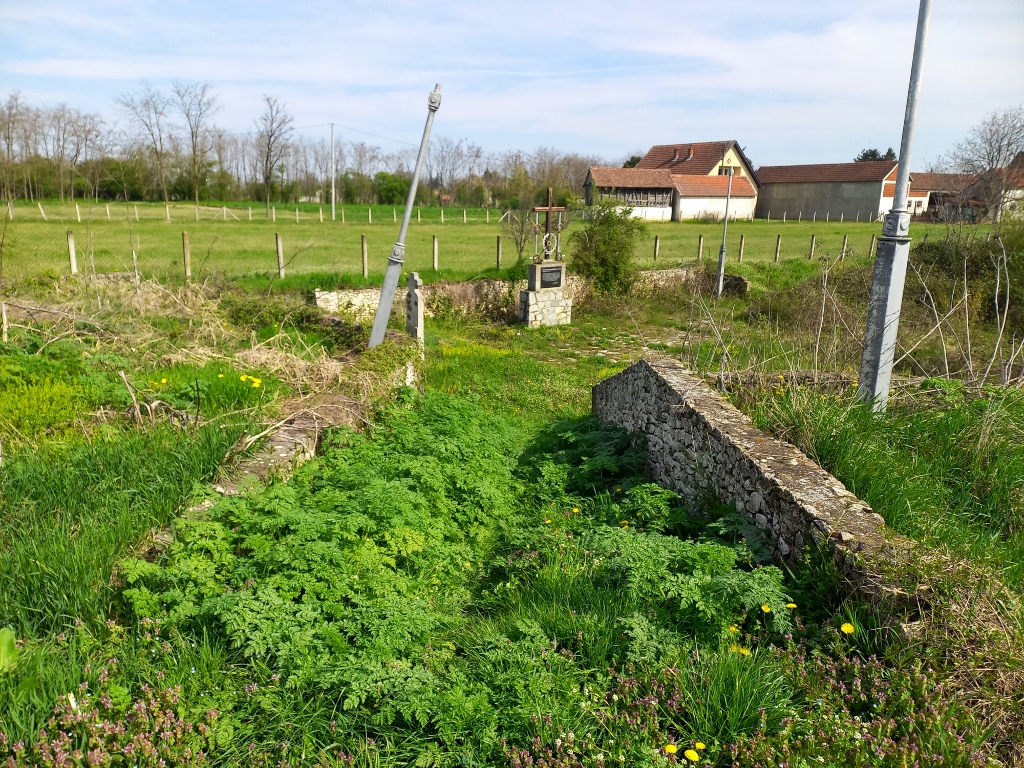 Landmark where 28 inhabitants of Prnjavor were killed in 1914
Landmark where 28 inhabitants of Prnjavor were killed in 1914
In August 1914, at the very beginning of WWI, the Austro-Hungarian army killed a total of 352 inhabitants of Prnjavor, i.e., civilians. 28 of them were executed at this concrete site. Later, railway workers of Serbia built a monument here in the shape of a stone pedestal, with a cross on top decorated with a laurel wreath and two crossed spears. The monument also exhibits a marble slab with an engraved quote from a report prepared by criminologist Archibald Reiss whom I have mentioned several times in my travel stories. For instance, when I visited Topčider area in Belgrade (https://www.svudapodji.com/en/belgrade-2022/).
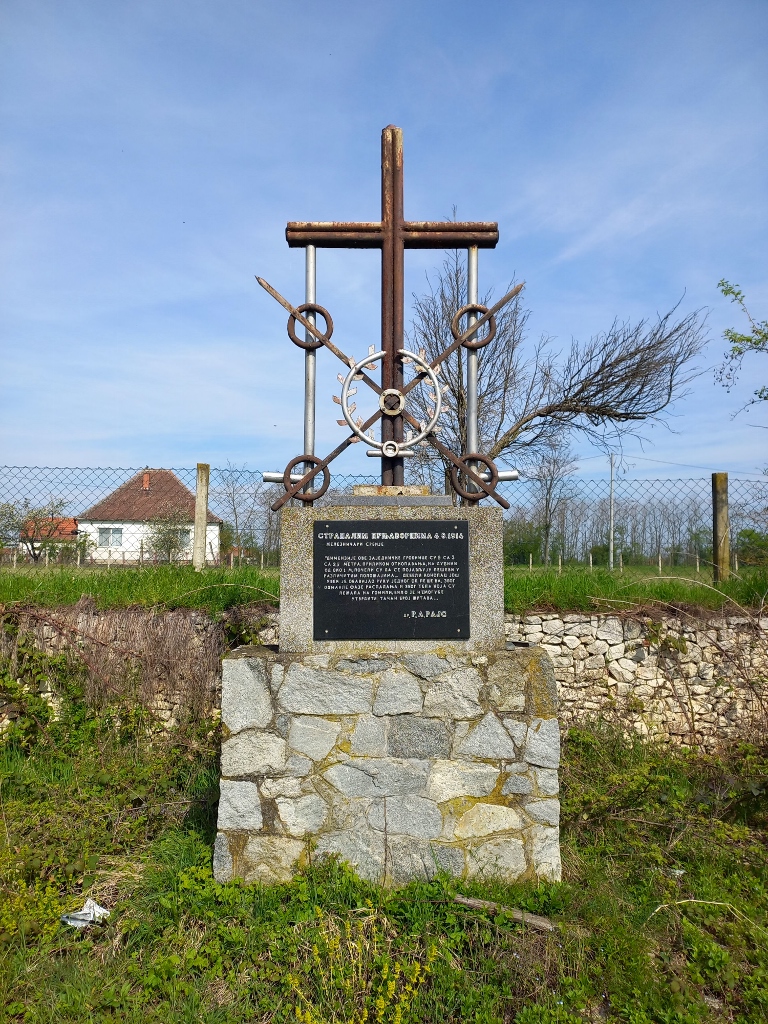 Monument to residents of Prnjavor executed by firing squad
Monument to residents of Prnjavor executed by firing squad
As a specialist in criminology and one of the pioneers of forensic medicine, Archibald Reiss came from Switzerland to Serbia after the liberation in 1914 in order to work on the crimes of the Austro-Hungarian, German and Bulgarian armies. Here is what, among other things, he wrote in his report about this place:
“... During the excavation, at the depth of around 1 m, corpses in different positions started to appear... A thick rope was still enwrapping an arm of a corpse, because of the advanced phase of decay and because of the bodies that were lying piled up, it was impossible to determine the exact number of victims...”
Beside this monument, there is another one here in the shape of a gravestone with inscription: “This is where Austro-Hungarians executed by a firing squad 28 martyrs on 4.8.1914.“
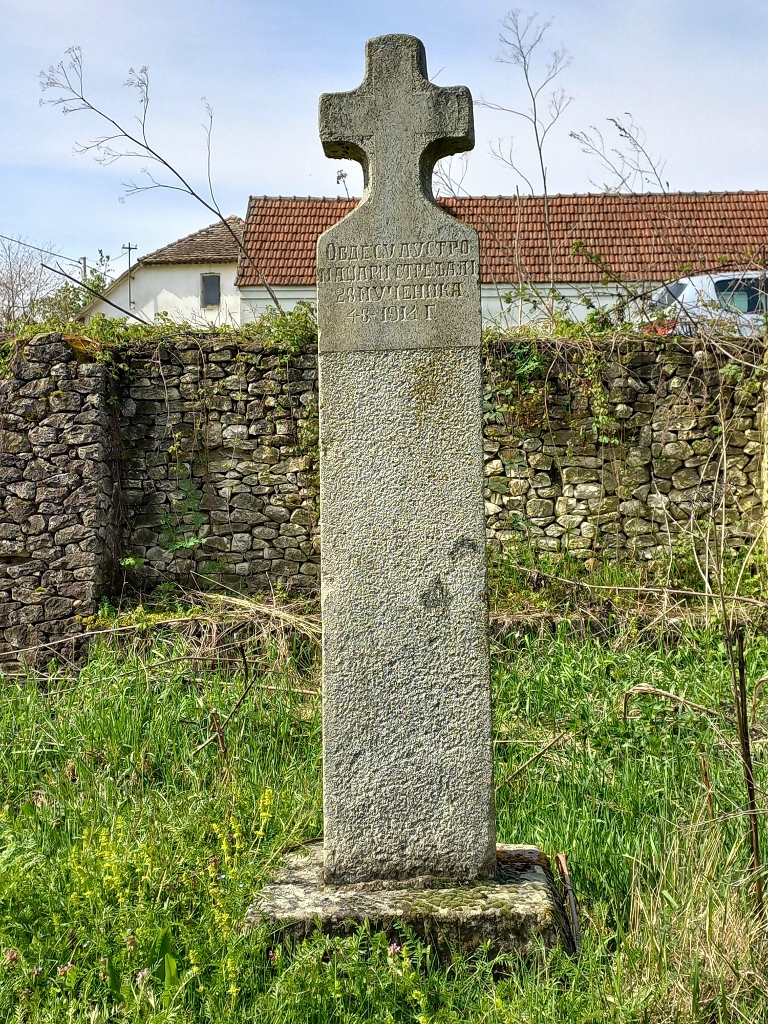 Second monument to residents of Prnjavor executed by firing squad
Second monument to residents of Prnjavor executed by firing squad
Then I moved to the Memorial Ossuary in Mačvanski Prnjavor that is located in the yard of the Church of St. Elijah.
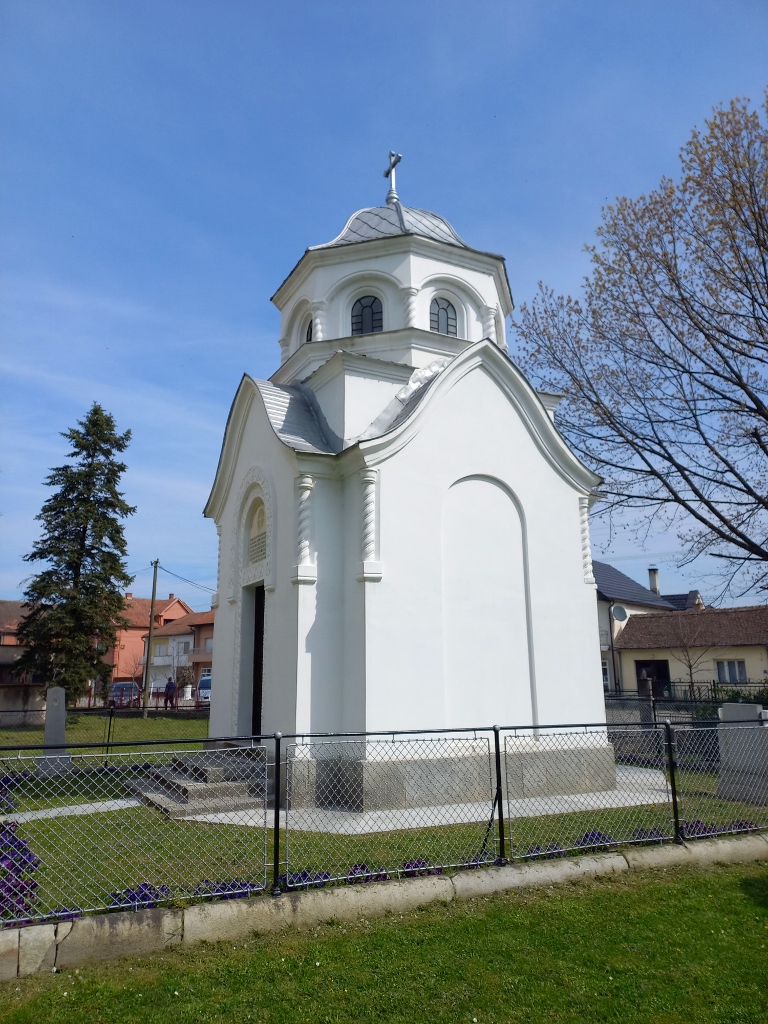 Memorial Ossuary in Mačvanski Prnjavor
Memorial Ossuary in Mačvanski Prnjavor
This memorial ossuary is a monument of culture of exceptional importance. It was built in 1922 and dedicated to the civilian victims killed by Austro-Hungarians, as well as the Serbian soldiers who perished in the Balkan Wars (1912-1913) and WWI. It contains the remains of 387 men and women. When you enter the chapel that was built above the ossuary, you can see slabs with the names of the people buried here, as well as short mention about who was killed where and in which manner. It is absolutely horrifying when you read that in addition to the fact that many of them were executed by firing squad, dozens of them were burned alive, either in a school or in a private house. Just to reiterate – these atrocities over civilian population were committed by the forces of the “civilised” Austria-Hungary (those who back home danced to the tune of waltz and ate Sachertorte).
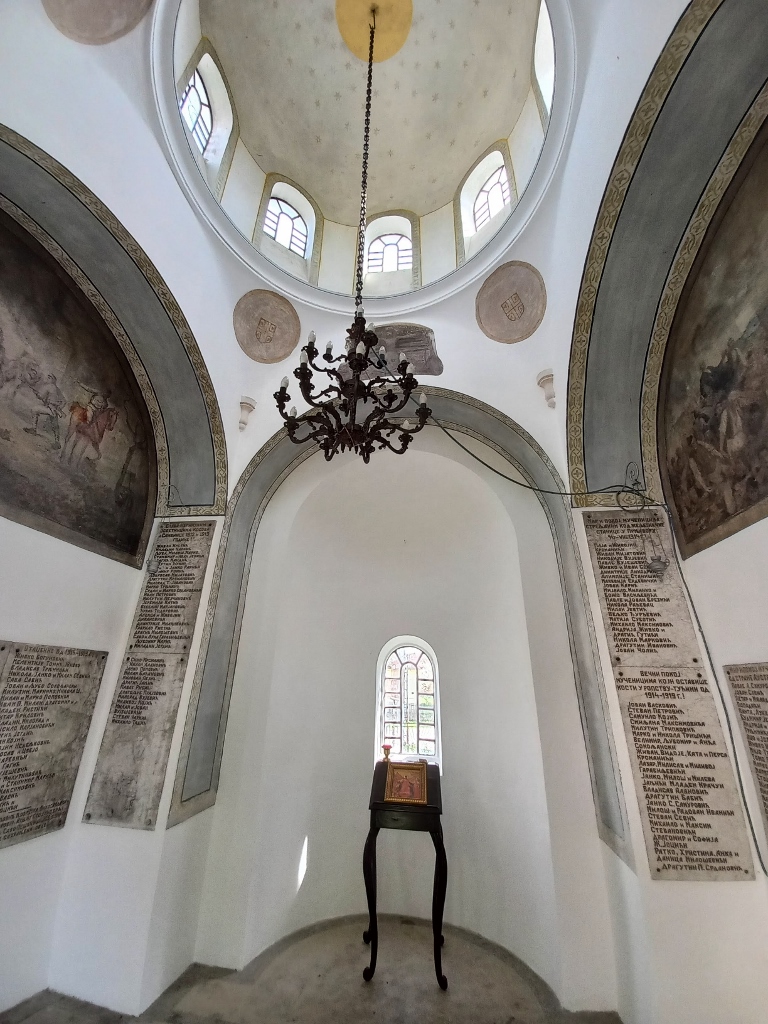 Memorial Ossuary in Mačvanski Prnjavor, the interior
Memorial Ossuary in Mačvanski Prnjavor, the interior
In the churchyard, there is also a monument to Archibald Reiss and here I also visited the Church of Saint Elijah.
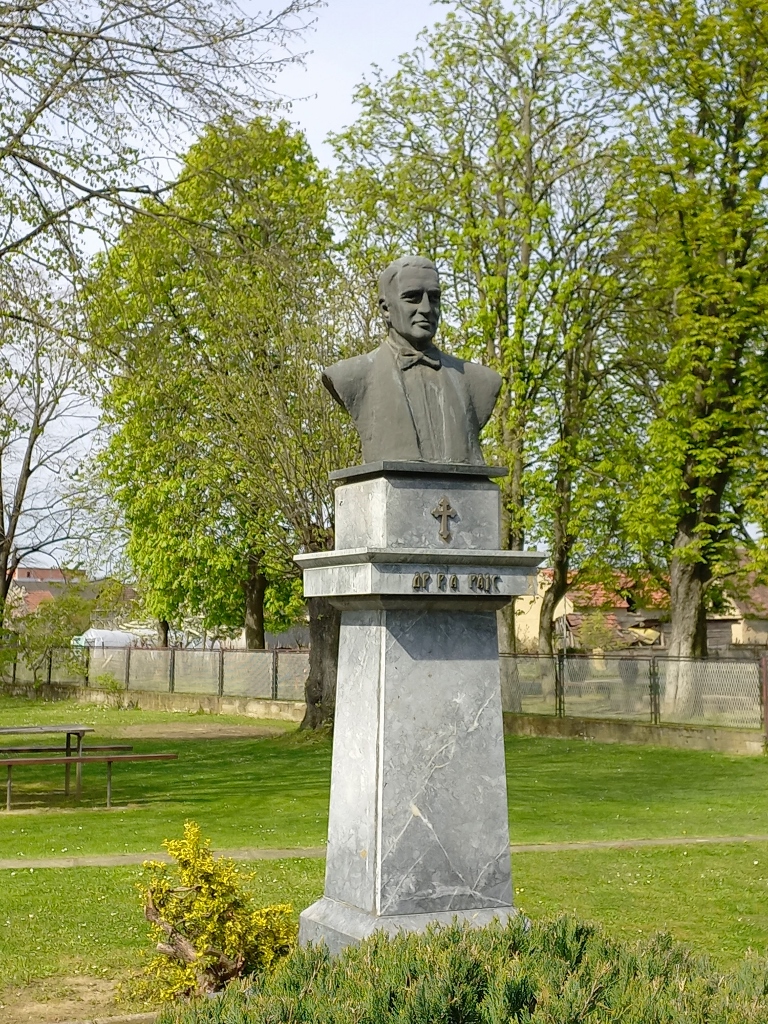 Monument to Archibald Reiss in Mačvanski Prnjavor
Monument to Archibald Reiss in Mačvanski Prnjavor
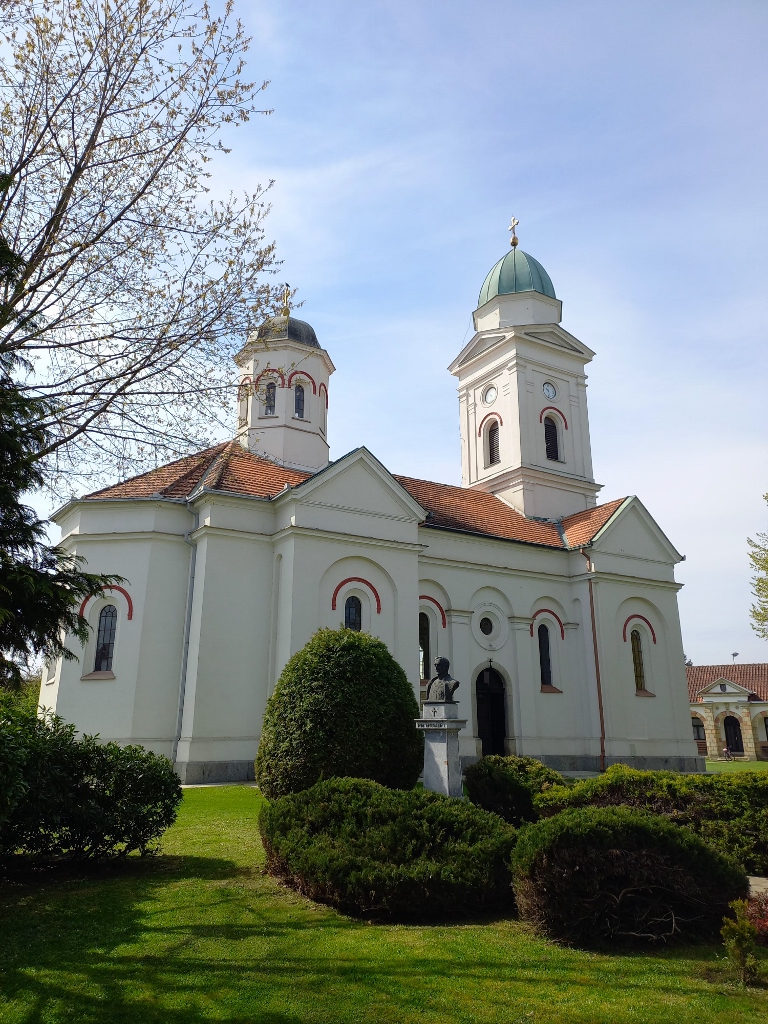 Church of Saint Elijah in Mačvanski Prnjavor
Church of Saint Elijah in Mačvanski Prnjavor
There is a small slab on the church that says the church was built in 1909 by Mihailo Samurović, a merchant from Šabac, and his wife Draginja, who were both born here in the village. They built the church as their endowment on a piece of land that they owned. I always find it impressive when some people are ready to give up a part of their wealth for something to outlast them, but which is used by others. Admittedly, these two people built the church as the endowment to their “dear, departed children and ancestors,” while inside the church there is a grave where the unfortunate parents buried all of their four children. Today, there is a table with icons and books positioned above the grave, so that nobody could inadvertently step over the place where the children were laid to rest.
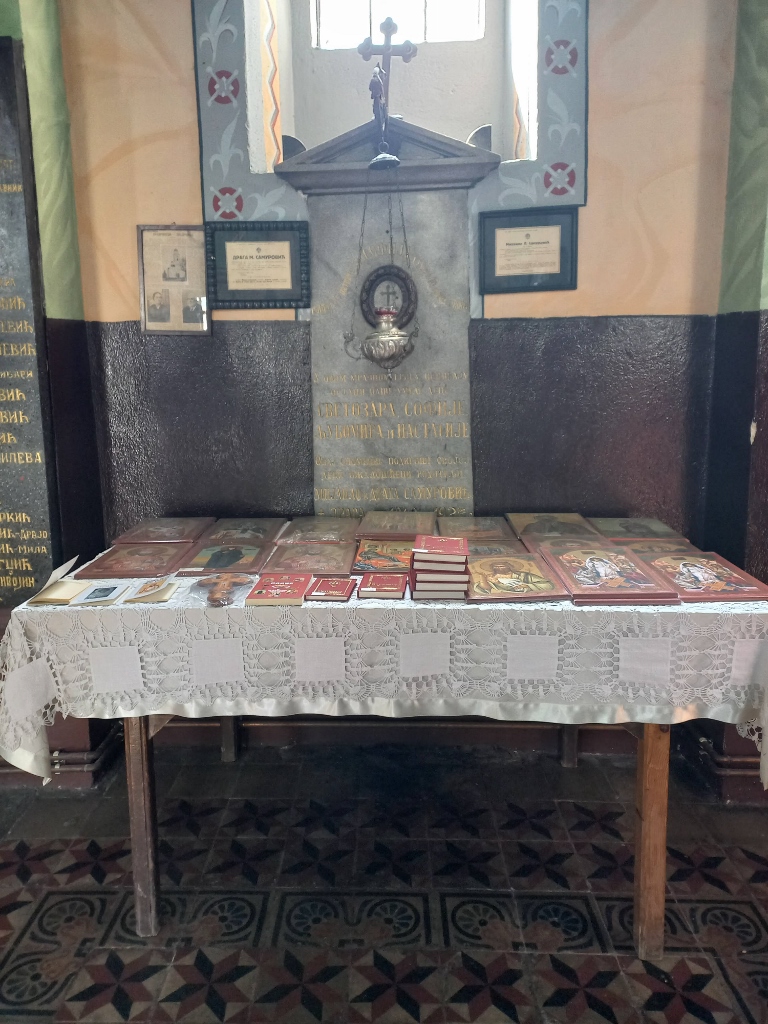 Church of Saint Elijah, a detail
Church of Saint Elijah, a detail
By the way, the church has a rather nice and harmonious interior, and I was very lucky to encounter verger Dragan with whom I had a fine chat.
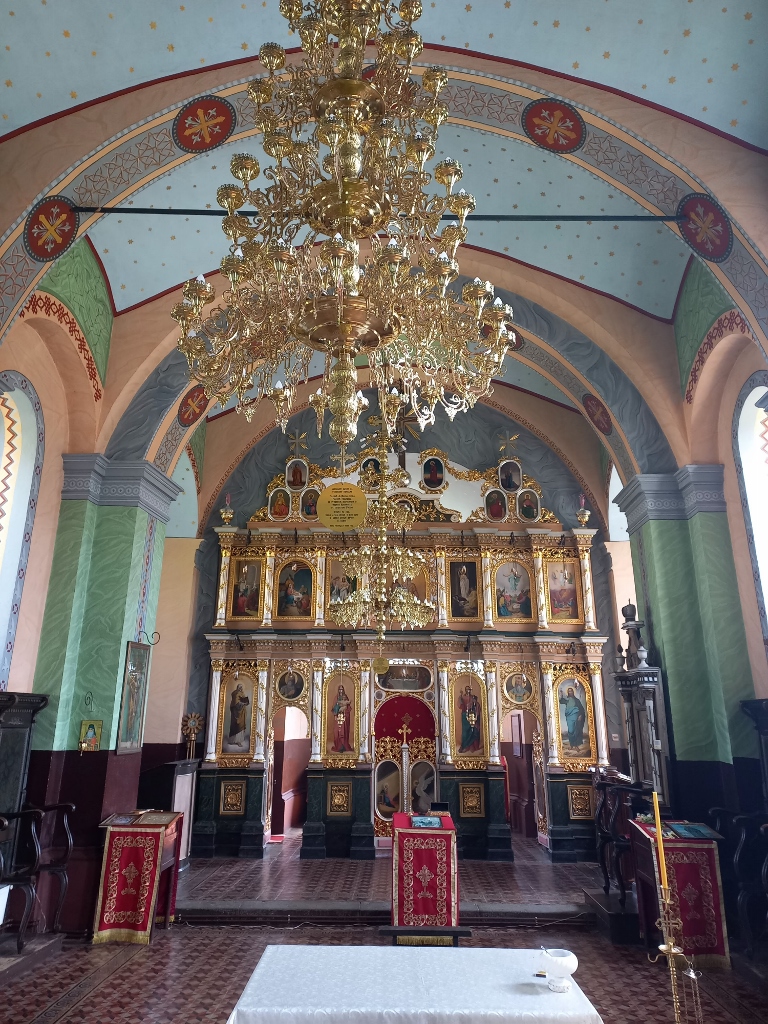 Church of Saint Elijah, a detail
Church of Saint Elijah, a detail
As I was lighting candles at the end of my visit, verger Dragan took a small icon and a cross which he gave to me as a gift. I was truly touched and then I left the gift in my car to guard me on my travels.
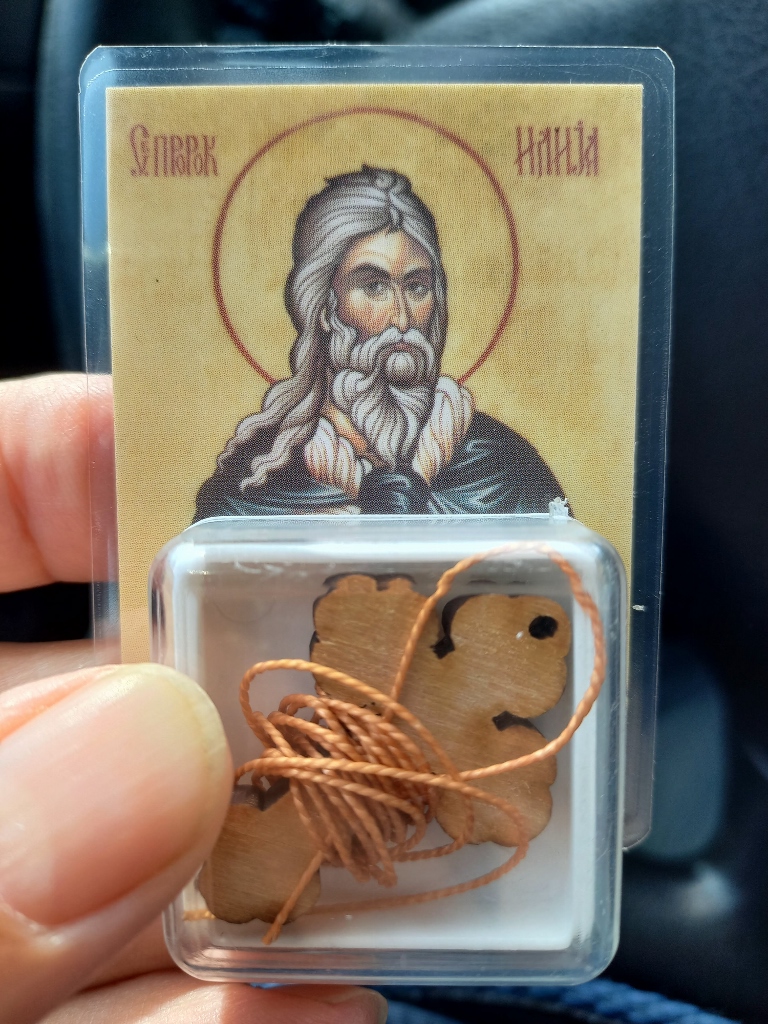 Gift from the Church of Saint Elijah in Mačvanski Prnjavor
Gift from the Church of Saint Elijah in Mačvanski Prnjavor
Now I drove to the Čokešina Monastery (Чокешина) that is a monument of culture of great importance.
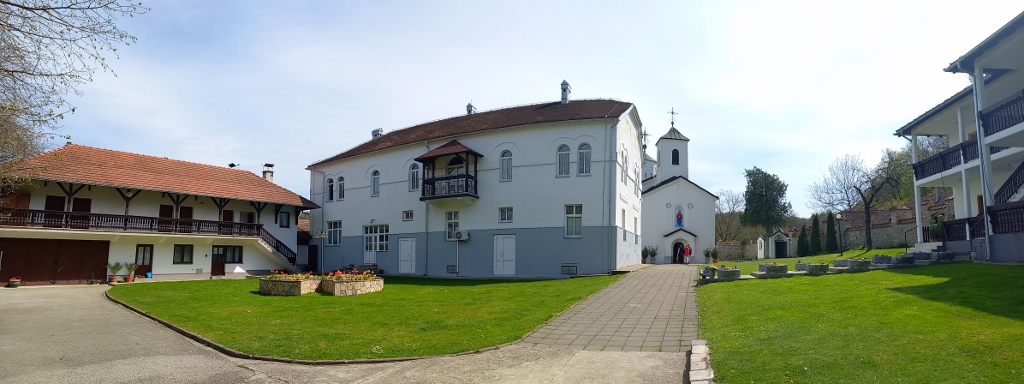 Yard of the Čokešina Monastery
Yard of the Čokešina Monastery
According to a legend, the monastery was founded here by the great Serbian epic hero Miloš Obilić. This is the legend, but what is known for sure is that the monastery existed in the 15th century. In the 18th century, the Ottomans set the monastery on fire and demolished it and a new church was built on those foundations in 1786. However, during the Battle of Čokešina in 1804, which was a part of the First Serbian Uprising [against the Ottomans], the monastery was burned down again and destroyed. The church that can be seen here today was built between 1820 and 1823, and it is dedicated to the Nativity of the Theotokos.
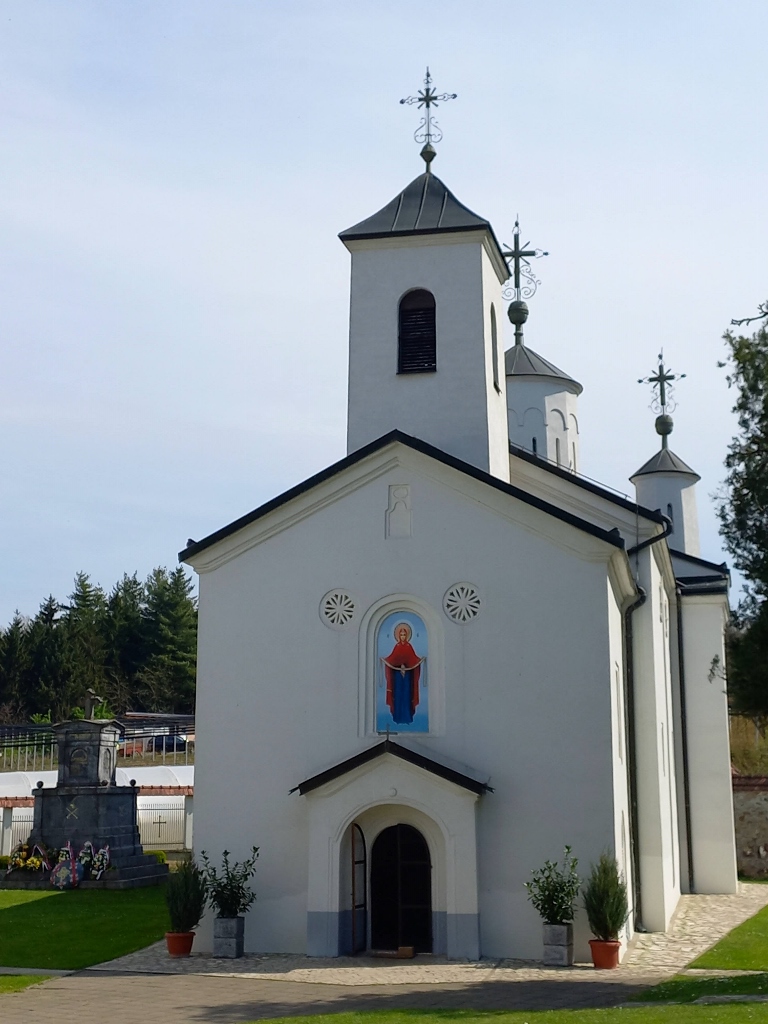 Čokešina Monastery’s Church of the Nativity of the Theotokos
Čokešina Monastery’s Church of the Nativity of the Theotokos
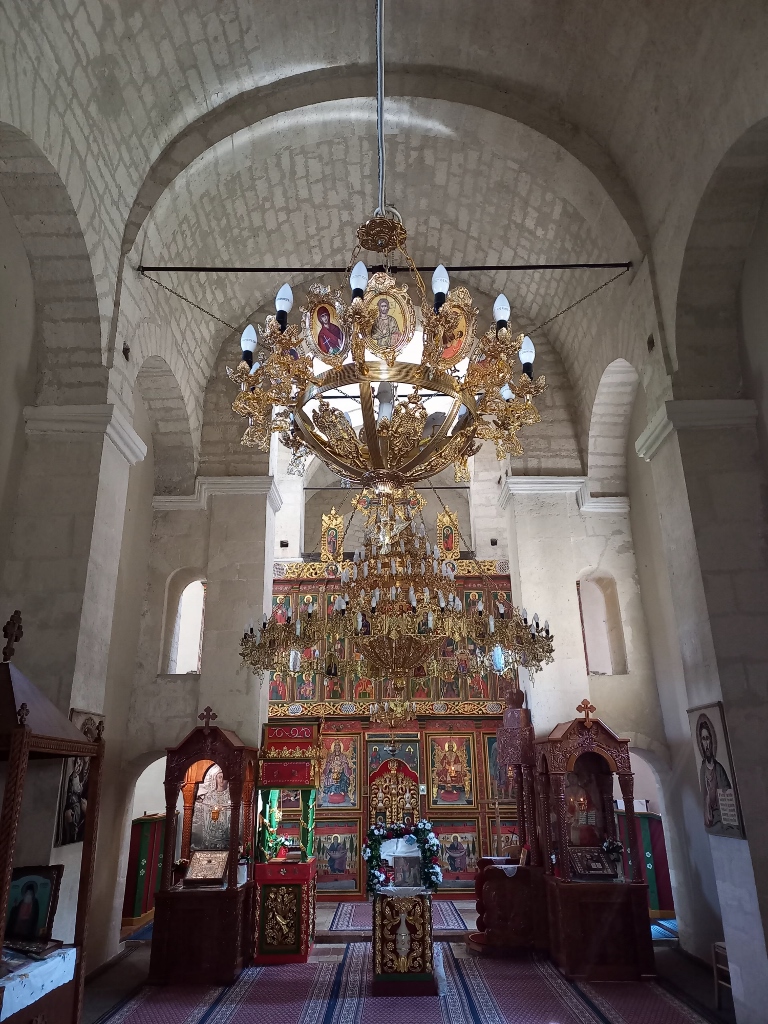 Church of the Nativity of the Theotokos, the interior
Church of the Nativity of the Theotokos, the interior
The iconostasis is from 1834.
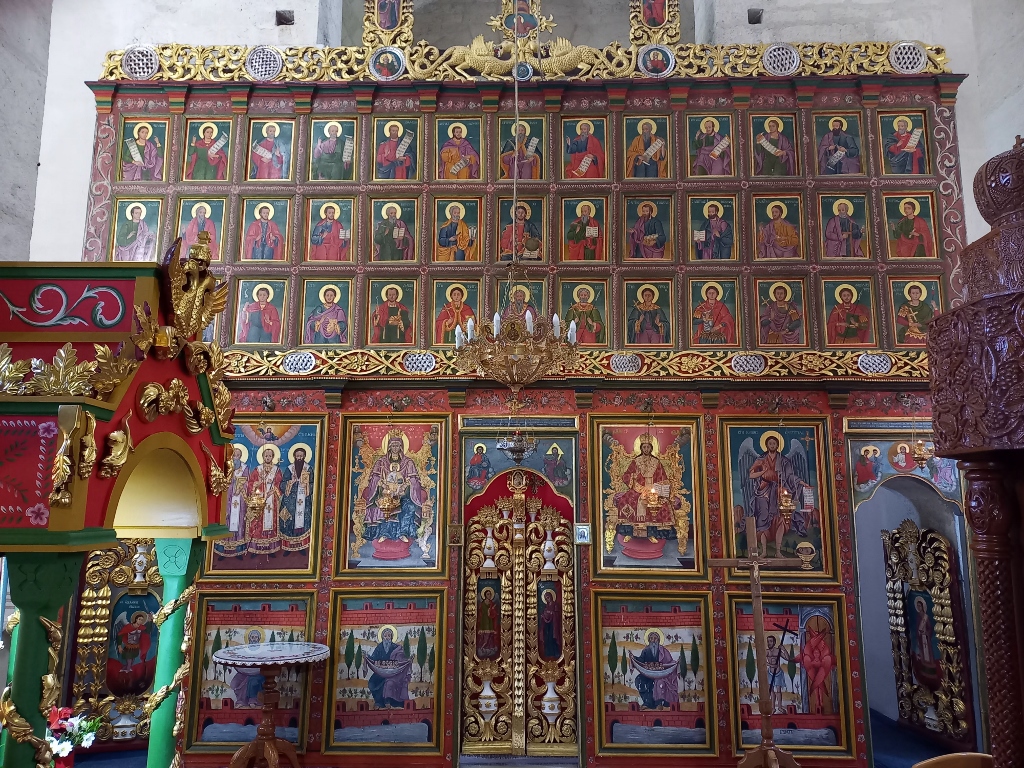 Church of the Nativity of the Theotokos, the iconostasis
Church of the Nativity of the Theotokos, the iconostasis
The monastery was destroyed yet again in the bombing of 1941, but it was restored in 1962.
In the monastery’s yard, there is a monument raised here in the memory of the Serbian rebels who were all killed in that battle of 28 April 1804.
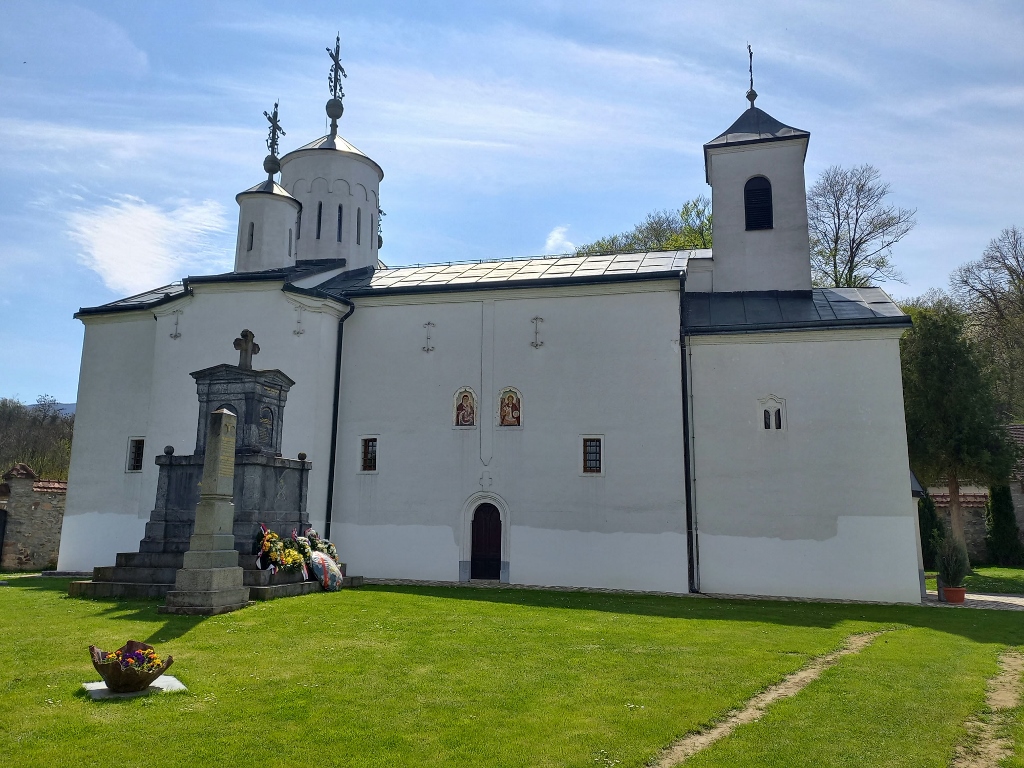 Church of the Nativity of the Theotokos and the monument to the Serbian rebels
Church of the Nativity of the Theotokos and the monument to the Serbian rebels
There were 1500 Ottoman soldiers who came from Bosnia, with only 303 Serbian soldiers and because of this number the Battle of Čokešina is often called the Serbian Thermopylae. In fact, a few of the Serbian soldiers did survive the battle itself, but they all soon died from the sustained wounds and later they were all buried here beside the church. Regardless of the defeat, the battle did help slow down the Ottoman forces and the rebels liberated Šabac already at the beginning of May 1804. For this reason, because of their merit, the Serbian fighters in the Battle of Čokešina have become legendary as great heroes.
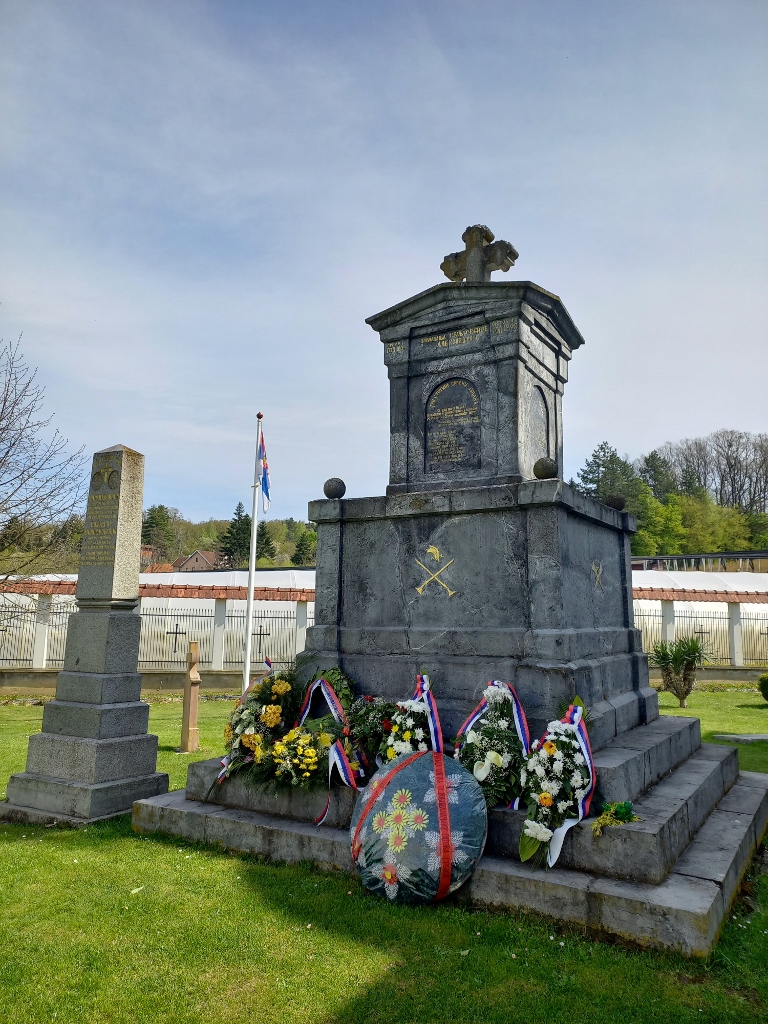 Monument to the Serbian rebels who perished in the Battle of Čokešina
Monument to the Serbian rebels who perished in the Battle of Čokešina
The concrete site where the battle took place, according to what I’ve read, is a little farther from the monastery, marked by stone monuments and overgrown by forest, but I was not keen on looking for it. Namely, the next place that I wanted to visit was Petkovica Monastery which seems quite close on the map and there are even marked roads, admittedly some local ones, but a nun from the monastery advised me not even to try to go along that way, since the road was in a bad shape. She said the best thing to do was to return to Mačvanski Prnjavor, to the main road from Loznica to Šabac, and then to get to Petkovica Monastery from that side. This meant that I would go a little bit around, but as it happened this was not even the only place where I had to drive in this way. Well, I did not mind. After all, the entire region of Mačva which is flat and especially the mild slopes of mount Cer were very pretty, so the leisurely drive felt quite nice.
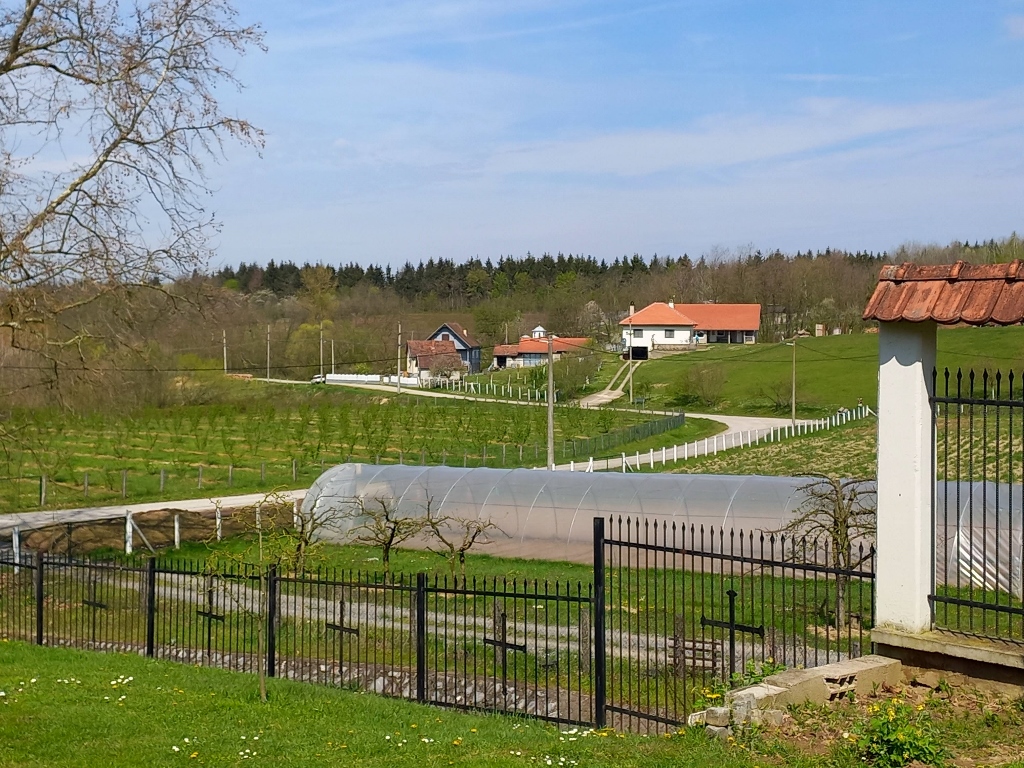 Surroundings of Čokešina Monastery
Surroundings of Čokešina Monastery
Petkovica Monastery (Петковица) is also situated in a pretty, predominantly agricultural area, tucked among the mild slopes of mount Cer.
 Surroundings of Petkovica Monastery
Surroundings of Petkovica Monastery
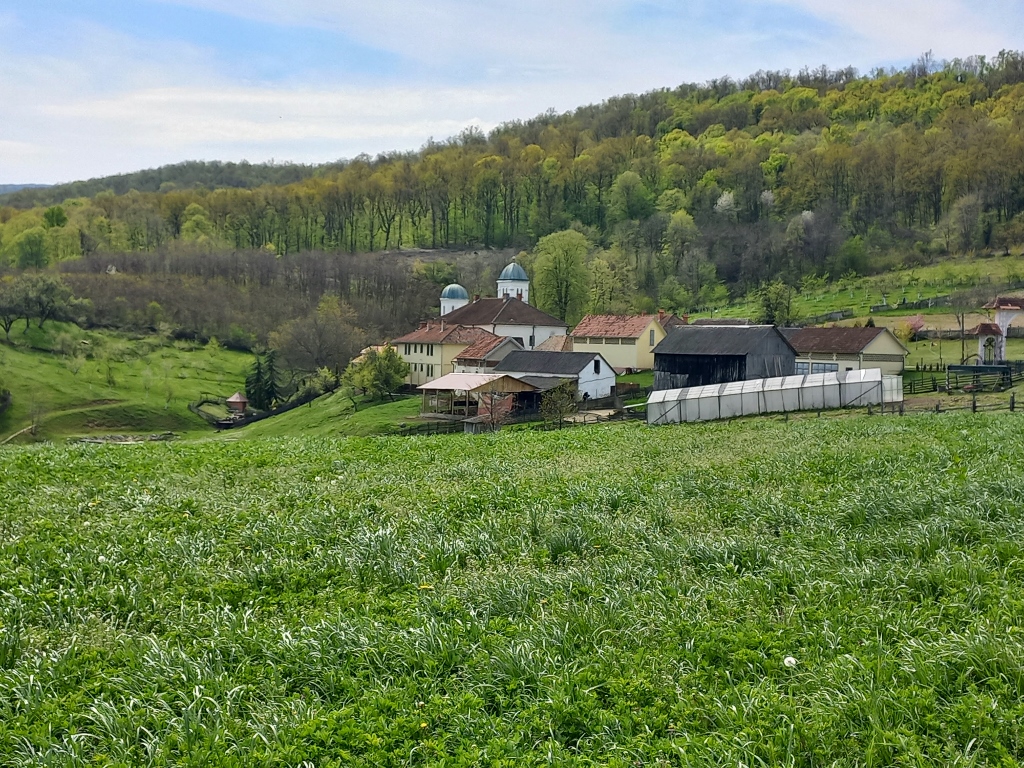 Petkovica Monastery
Petkovica Monastery
When I got to the monastery itself and parked the car, I heard the church bells and so I made a short video:
Then I headed for the churchyard.
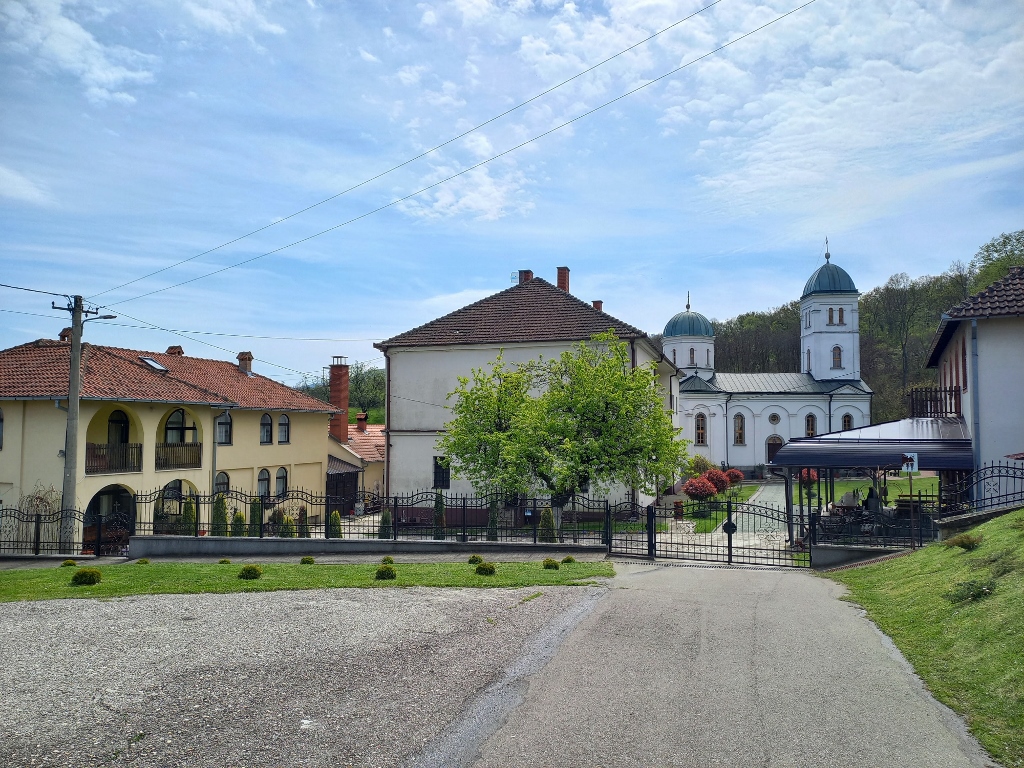 Petkovica Monastery
Petkovica Monastery
Here, I first came across, as it would turn out, the Abbess of the monastery, so when I bid her good morning, she asked me to help her move some wooden benches from the lawn to the concrete-paved porch. It was obvious to me that there had been a gathering of the people there, probably after the liturgy (it was Maundy Thursday), and then they went away leaving the benches out in the open. I thought that it was inappropriate that the people had left them there, since the abbess was a little elderly and was alone there when I came. I really did not mind doing this at all, so I moved the benches where they were supposed to be on my own, but the table we had to move together to the porch where I then positioned it as it should stand.
Petkovica Monastery near Šabac (there is a monastery of the same name on mount Fruška Gora in Ležimir) was first mentioned in 1561. During the First Serbian Uprising, the Ottomans burned down numerous churches and monasteries in Mačva, including Petkovica Monastery. After the liberation, the monastery was restored, but it was damaged again during WWI and WWII.
The church that can be seen here today was built in 1887 and it is dedicated to St. Petka – Saint Paraskeva of the Balkans.
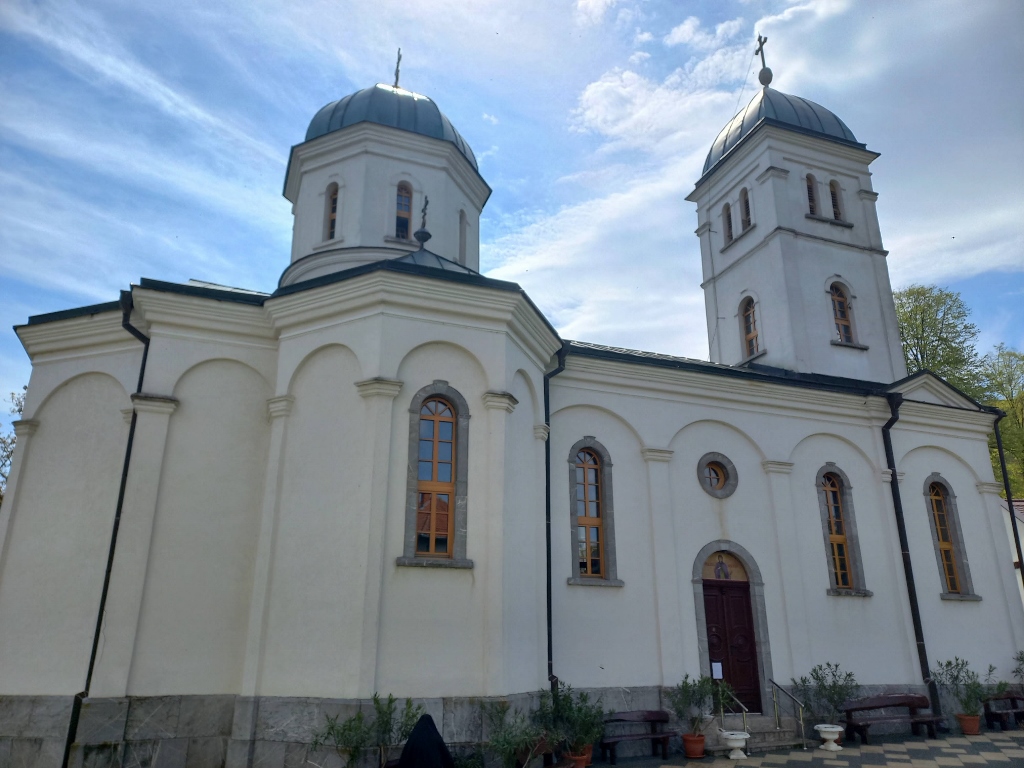 Church of Saint Paraskeva of the Balkans at Petkovica Monastery (Šabac)
Church of Saint Paraskeva of the Balkans at Petkovica Monastery (Šabac)
The church has a trefoil ground plan, with the apses being polygonal on the outside and semi-circular on the inside. Above the meeting point of the apses, there is a dome, while above the narthex there is a bell-tower.
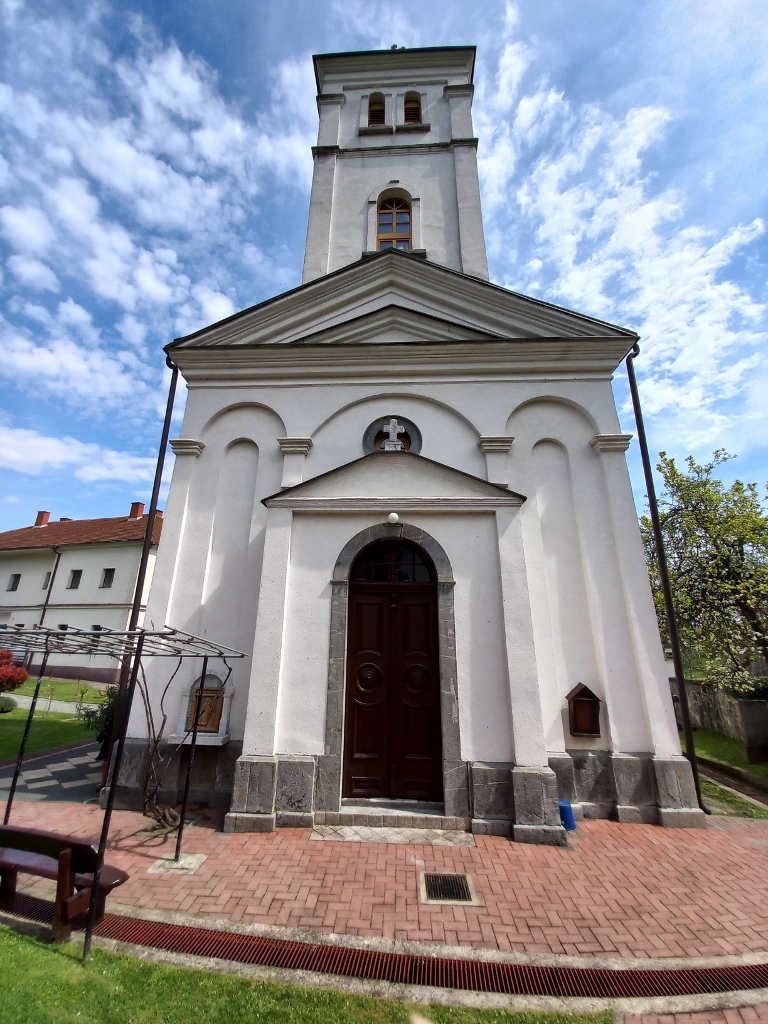 Church of Saint Paraskeva of the Balkans at Petkovica Monastery (Šabac)
Church of Saint Paraskeva of the Balkans at Petkovica Monastery (Šabac)
The facade was done using a combination of granite blocks applied for the socle and other details, and white-painted exterior walls. The front facade has a classicistic flair.
As for the frescoes, there is no official data and the only thing that is known for sure is that the icons were done by Nikola Marković (1843-1889) in the second half of the 19th century.
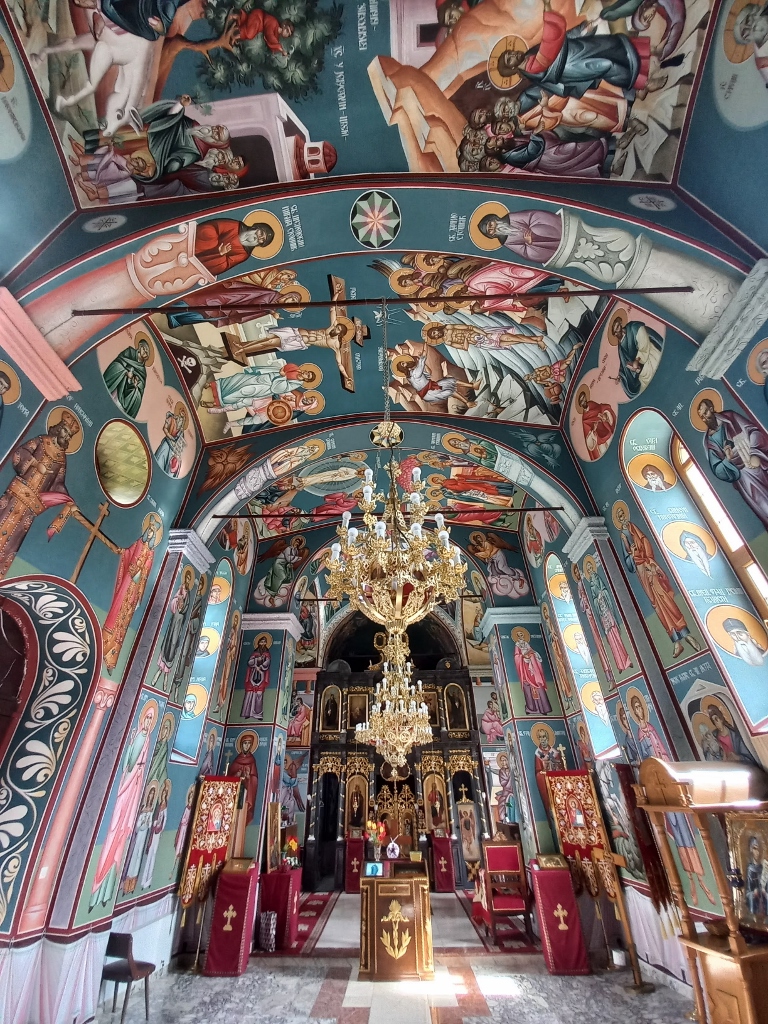 Church of Saint Paraskeva of the Balkans at Petkovica Monastery (Šabac)
Church of Saint Paraskeva of the Balkans at Petkovica Monastery (Šabac)
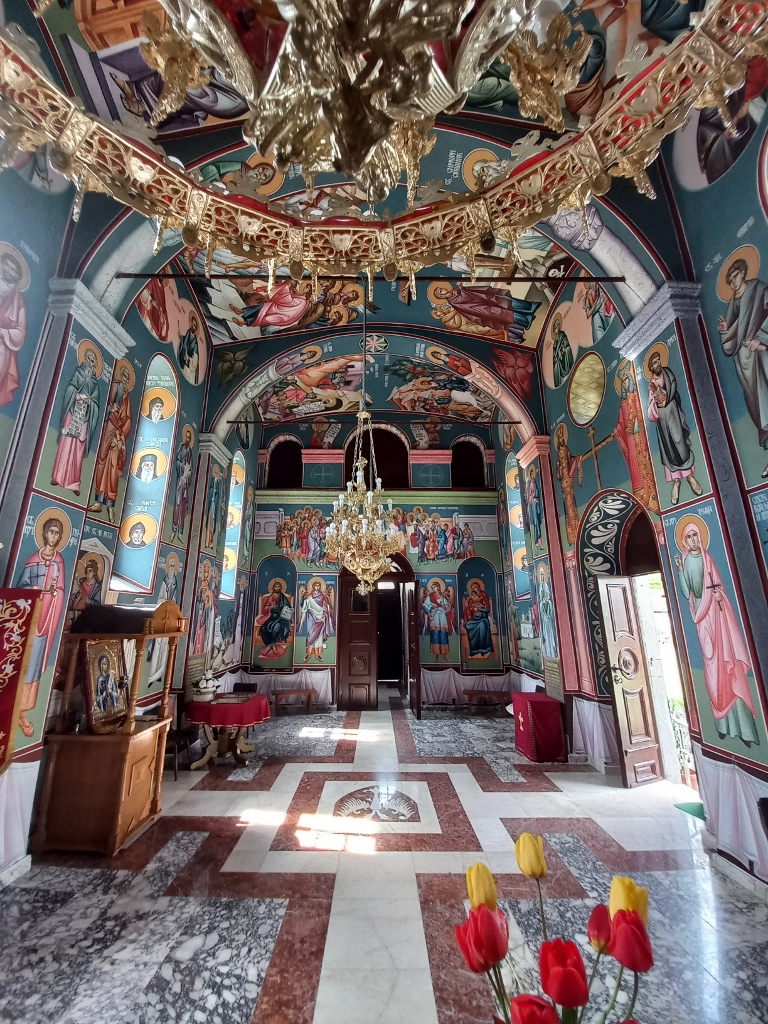 Church of Saint Paraskeva of the Balkans at Petkovica Monastery (Šabac)
Church of Saint Paraskeva of the Balkans at Petkovica Monastery (Šabac)
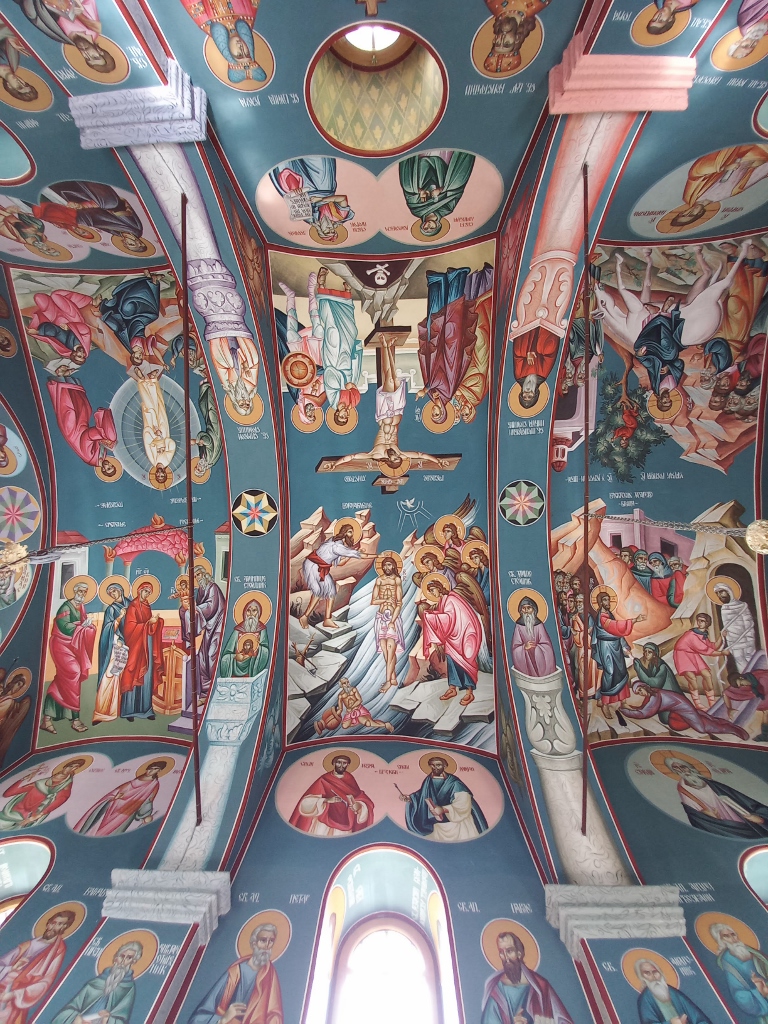 Church of Saint Paraskeva of the Balkans at Petkovica Monastery (Šabac)
Church of Saint Paraskeva of the Balkans at Petkovica Monastery (Šabac)
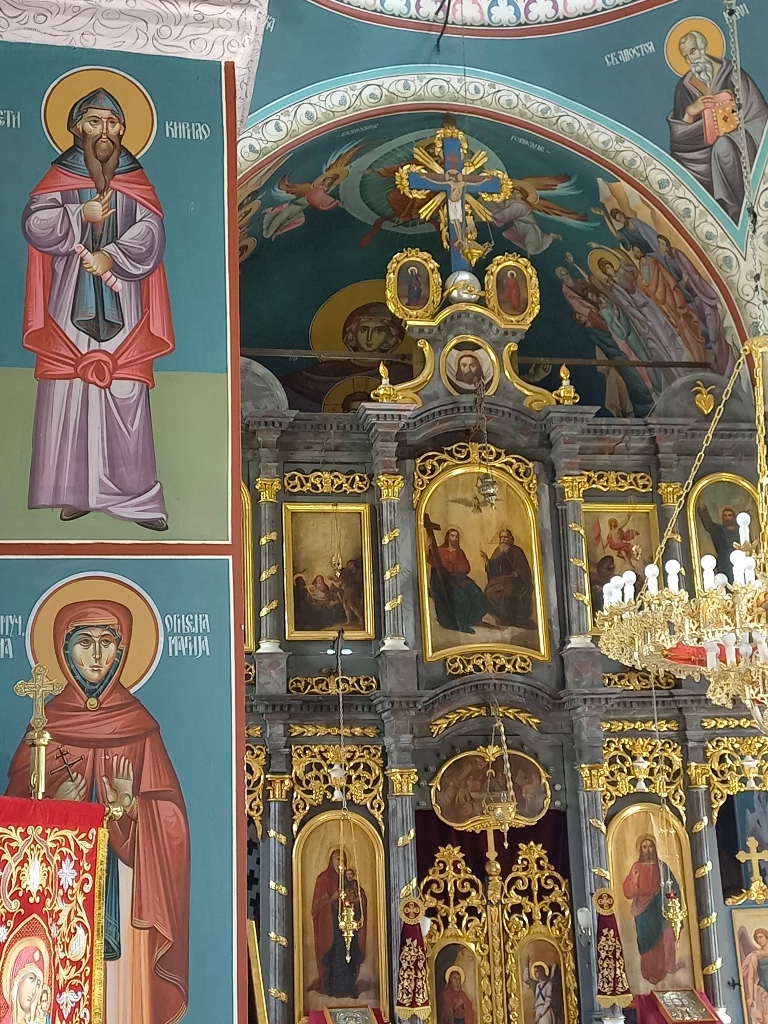 Church of Saint Paraskeva of the Balkans at Petkovica Monastery (Šabac)
Church of Saint Paraskeva of the Balkans at Petkovica Monastery (Šabac)
The abbess also showed me where the path was that leads from the churchyard to a nearby water spring. The water is widely believed to have medicinal properties.
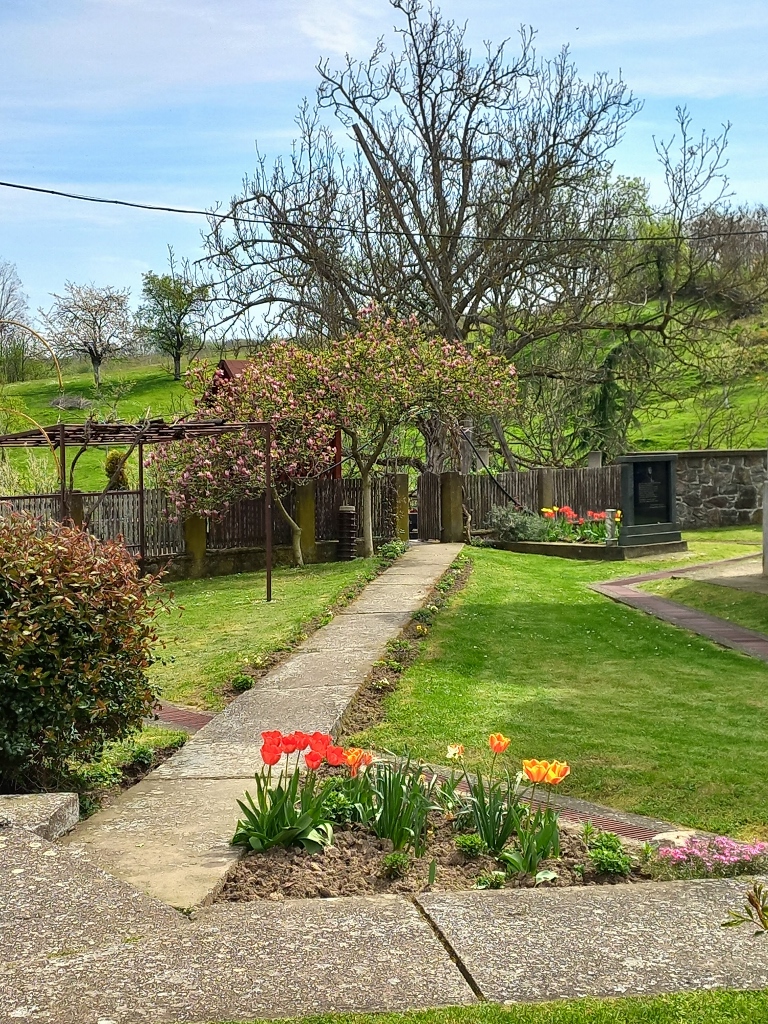 Petkovica Monastery, a detail
Petkovica Monastery, a detail
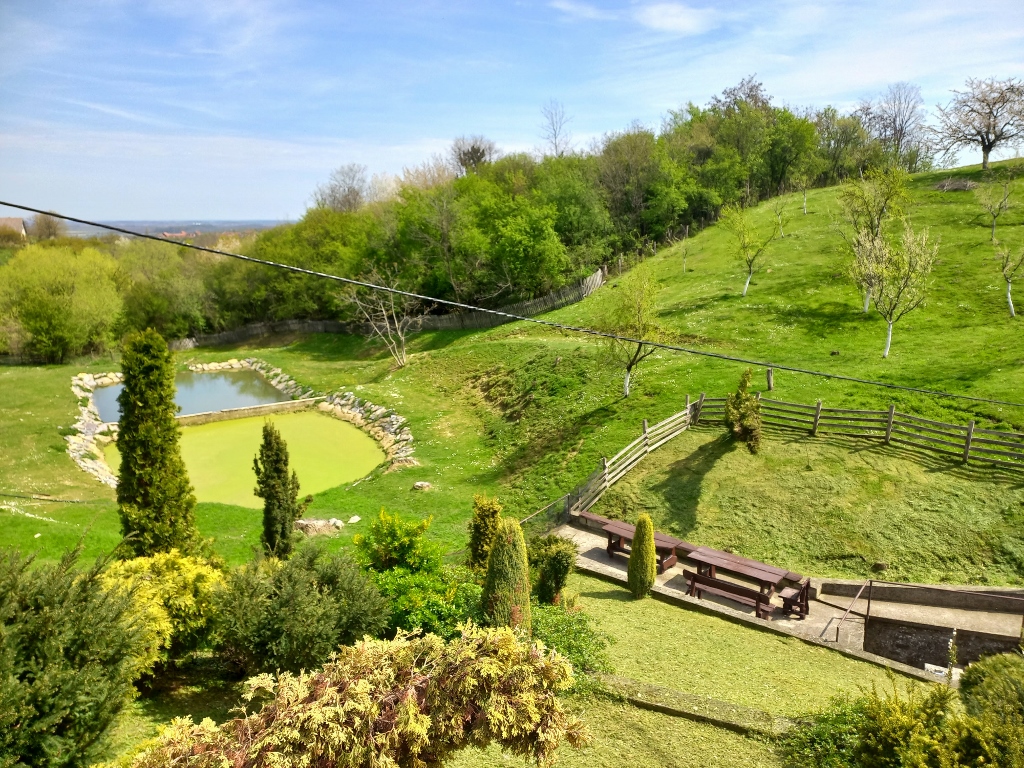 Petkovica Monastery, view from the level of the churchyard, while the built area around the spring is below and to the right
Petkovica Monastery, view from the level of the churchyard, while the built area around the spring is below and to the right
When I descended here, it turned out that the water was coming out of a pipe in a very weak flow. Still, there are wooden tables and benches here in case visitors would like to have a meal beside the water spring.
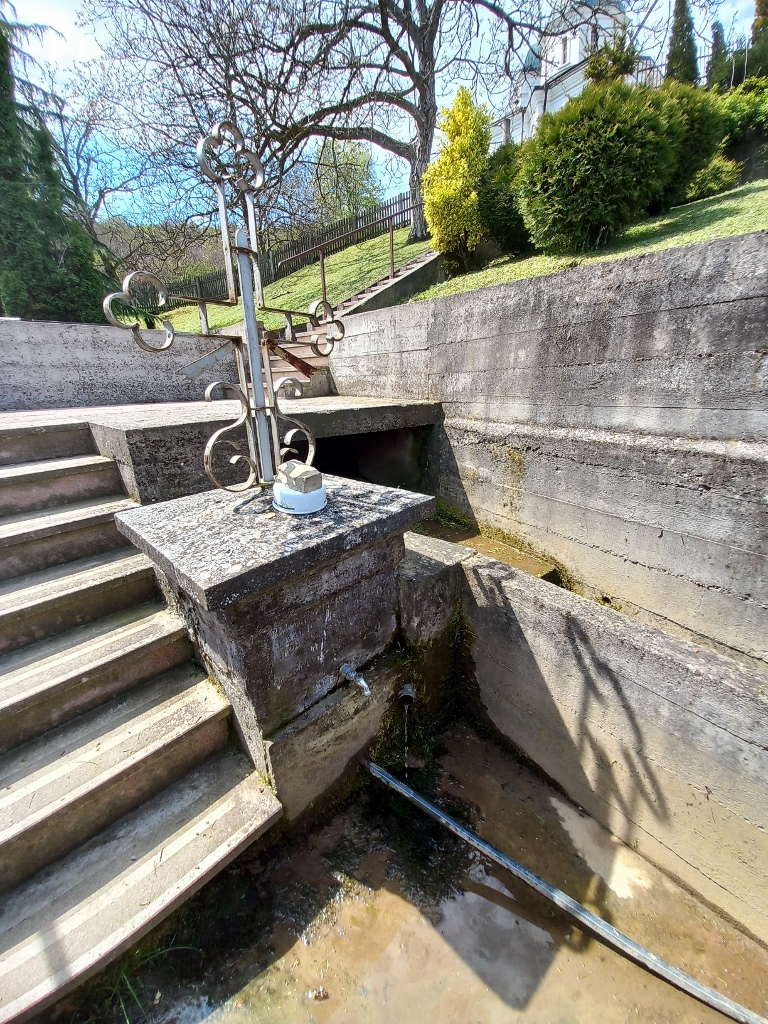 Petkovica Monastery, water spring
Petkovica Monastery, water spring
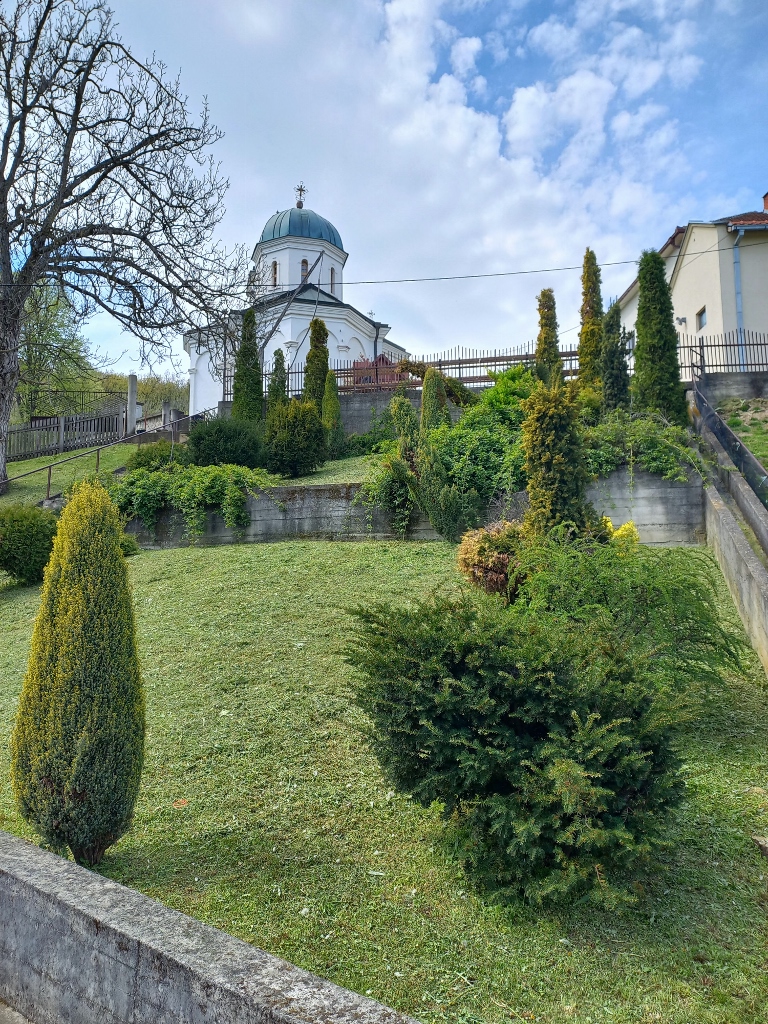 Petkovica Monastery, view towards the church
Petkovica Monastery, view towards the church
Once I finished with the sightseeing and taking photos here, I returned to the churchyard where I took a photo of beehives positioned above the nicely maintained flat section of the yard.
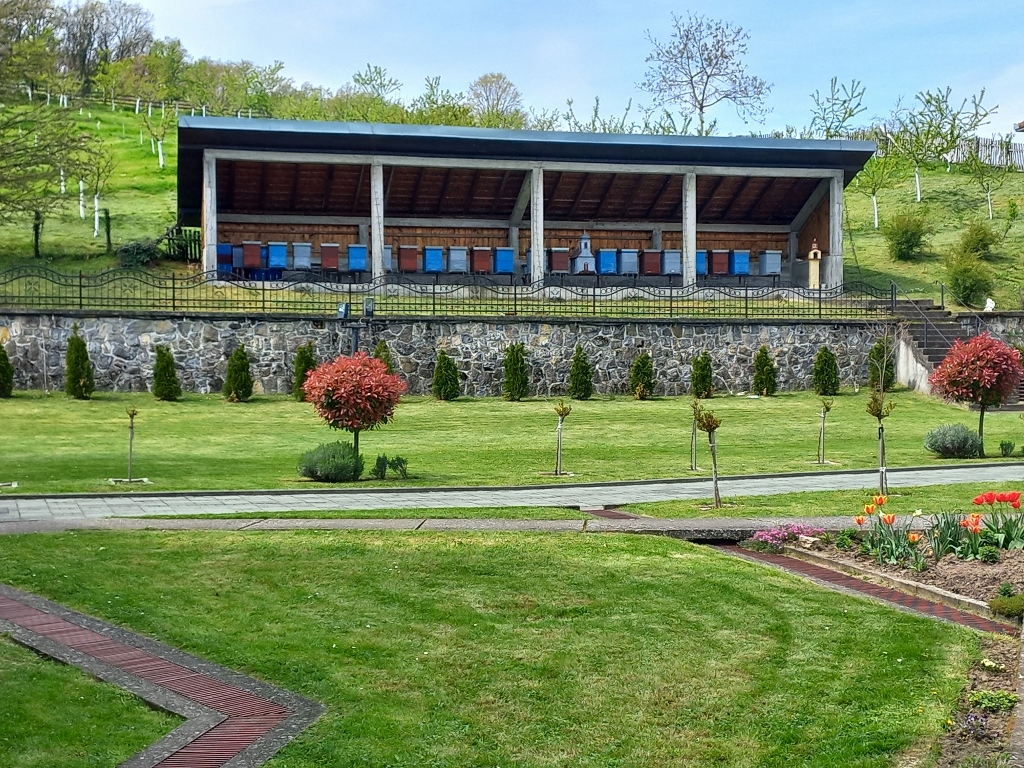 Petkovica Monastery, a detail
Petkovica Monastery, a detail
I was getting ready to leave, so I waved goodbye to the abbess from the gate and then she asked me if I would like to have some coffee. I hesitated a little, but then I looked at my watch and realised I had the time, so I accepted the invitation. Then she asked me if I could, while waiting for the coffee, go to the water spring with two 5 l canisters and bring her the water. Not a problem, of course, I would have done this without any coffee, but I smiled to myself and thought that this abbess was not naive. The only thing that “bothered” me was that the water flowed very slowly, so this whole thing took some time, but it all ended well. While I had my coffee, the abbess kept me company, so we spoke a little about all sorts of things.
Among other things, she asked me if I was married and when I said I wasn’t, she commented this in the style of: “You either get married or go to a monastery.” I think they could do here with a new person who still has some strength to move those benches around and bring water, but I’m afraid I’m not a monastery material. For many reasons.
In the end, I thanked her for the coffee and moved on. On my way to the car, I also noticed a few guineafowl in the monastery’s yard, but they were a little far away from me and as I was forced to use only my mobile phone (my photo-camera had broken), the photo is not sharp enough.
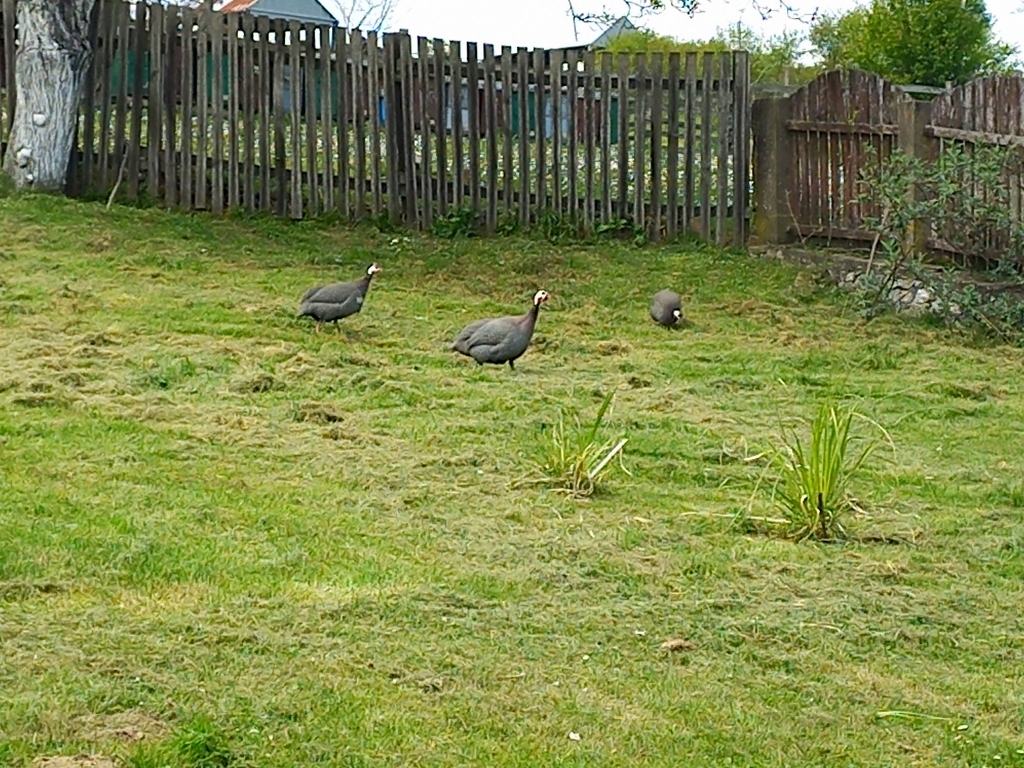 Petkovica Monastery, a detail
Petkovica Monastery, a detail
Driving back to the main road between Loznica and Šabac, I stopped at one point while I was still on the low slopes of mount Cer in order to take a photo of the lowland of Mačva.
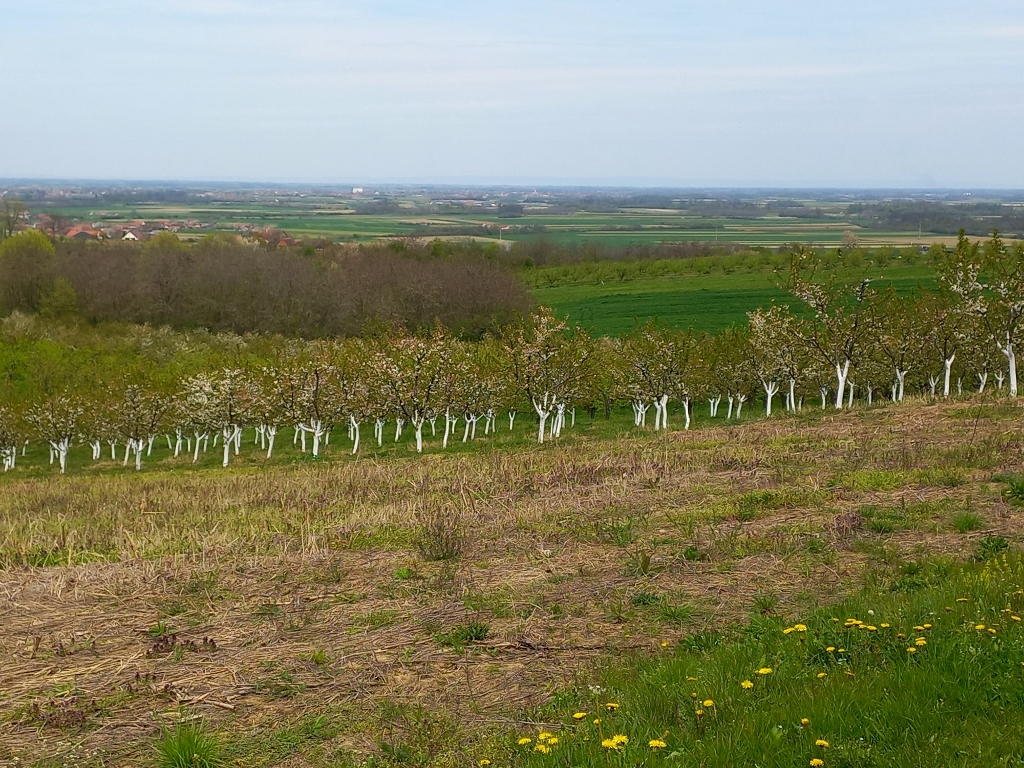 View at Mačva
View at Mačva
Now I drove to village Zminjak (Змињак) and the Church of the Ascension that is categorised as a monument of culture. There is a nice and spacious churchyard there, while the church is approached from the back side.
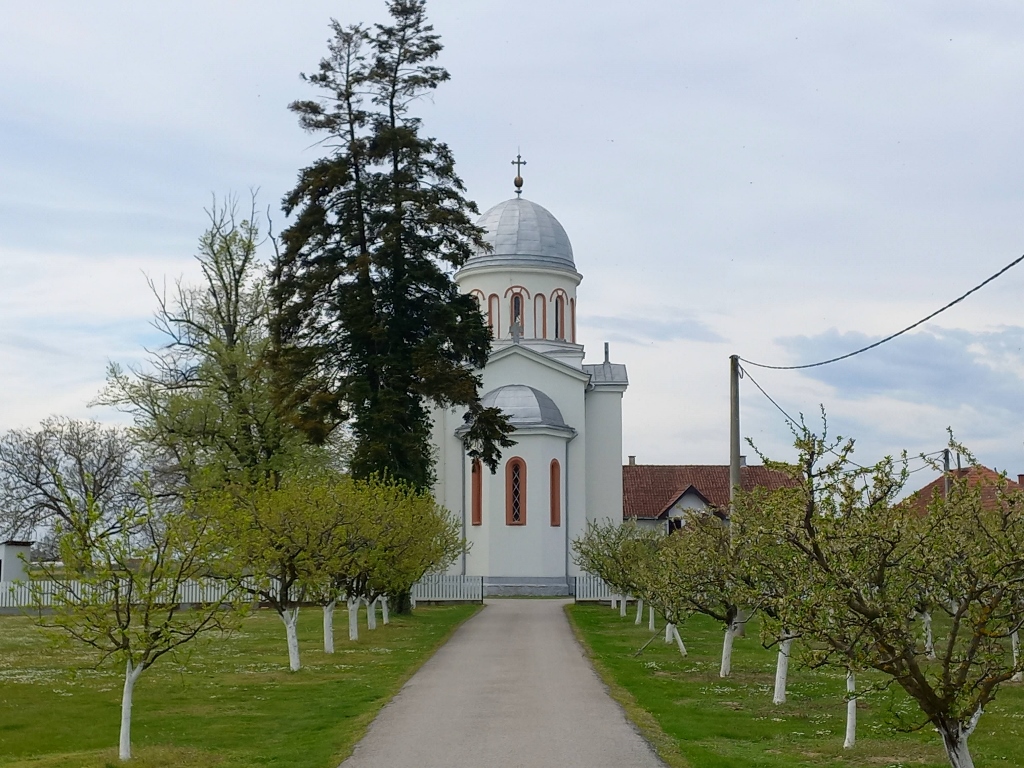 Church of the Ascension in Zminjak
Church of the Ascension in Zminjak
The church was built in the period between 1890 and 1896, and it was designed in line with the style that was predominant in the church architecture of Serbia at the time. The building has a cruciform plan and above the intersection of the cross’s arms there is a dome, while the shallow altar apse is three-sided.
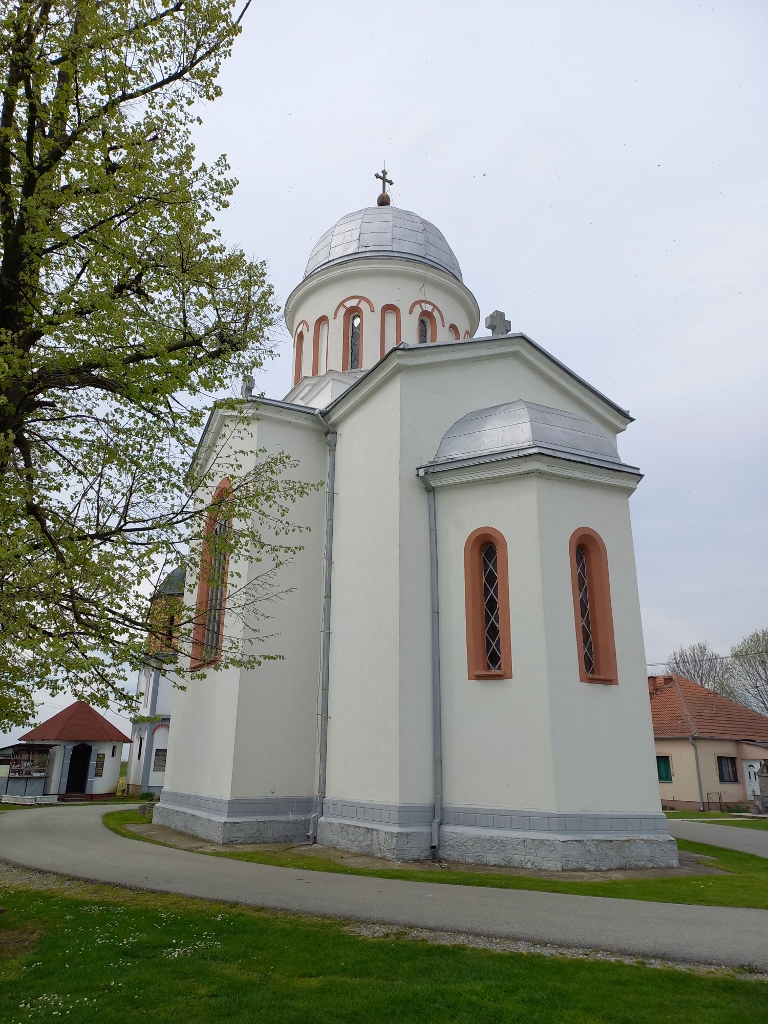 Church of the Ascension in Zminjak
Church of the Ascension in Zminjak
The side facades have large arched stone quadriforas, while the front facade on the west side is decorated by a doorway and a stone rosette.
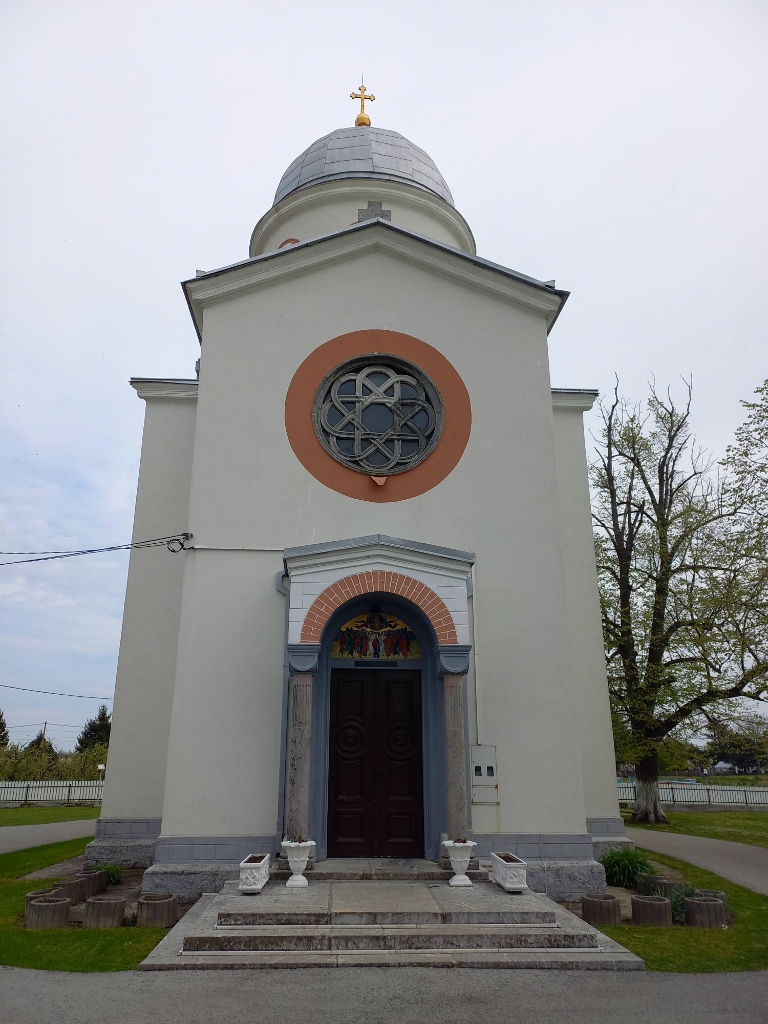 Church of the Ascension in Zminjak
Church of the Ascension in Zminjak
The interior is harmoniously decorated and the iconostasis was made in 1939.
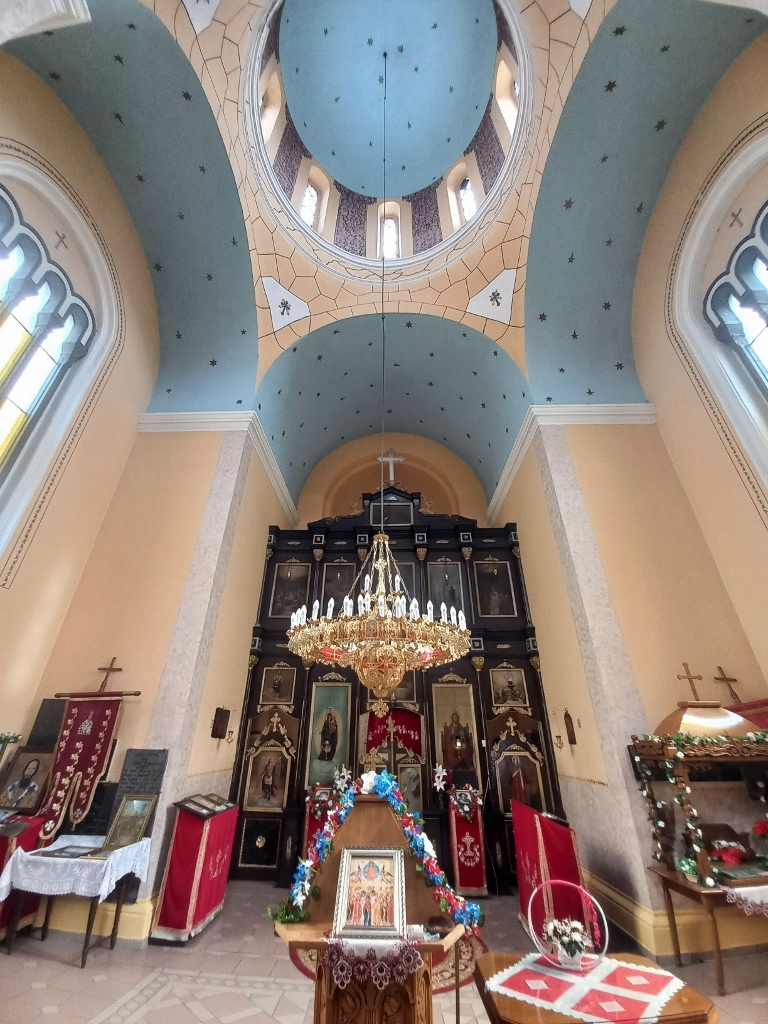 Church of the Ascension in Zminjak
Church of the Ascension in Zminjak
According to what I have read, the experts are of the opinion that the icons were painted by at least three different painters. Thus, for instance, the despotic icons of Jesus Christ and the Mother of God were most likely saved from the earlier iconostasis and then placed on this one that can be seen in the church today.
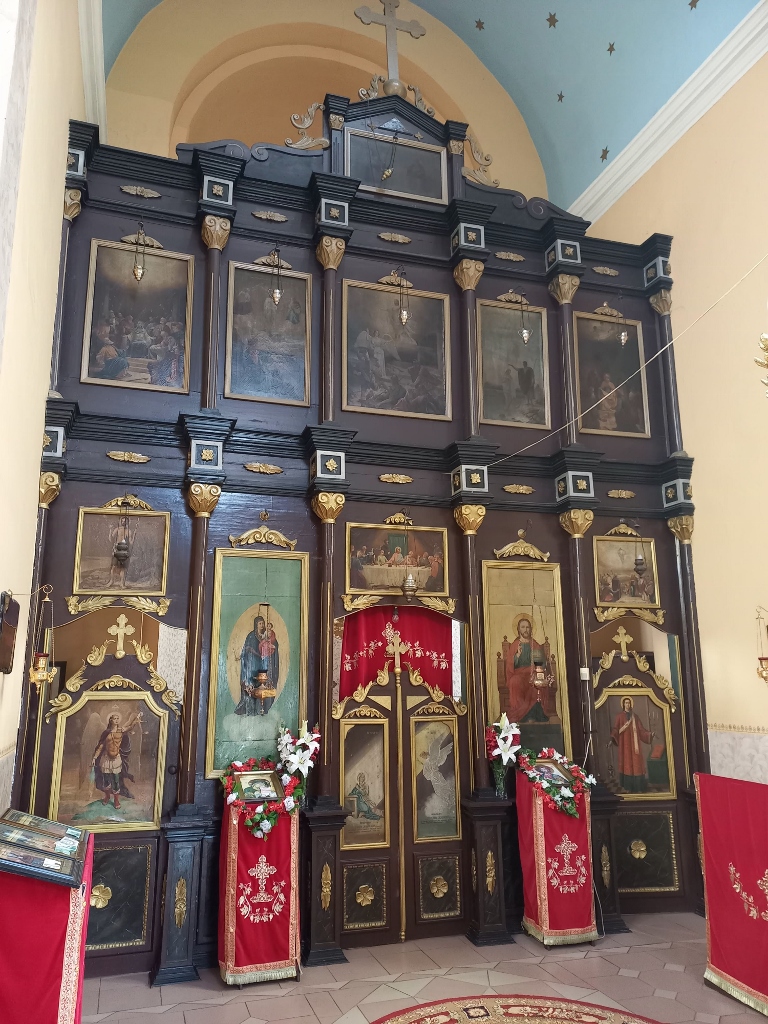 Church of the Ascension in Zminjak
Church of the Ascension in Zminjak
Following the visit to this church, I turned off the main road and headed for village Lipolist (Липолист). Once there, I first passed by a plant nursery and I thought it may be a good idea to stop there. Later I realised that this was quite a well-known plant nursery, but I actually did not care. Even without knowing this I bought a couple of plants, while also taking a few photos along the way.
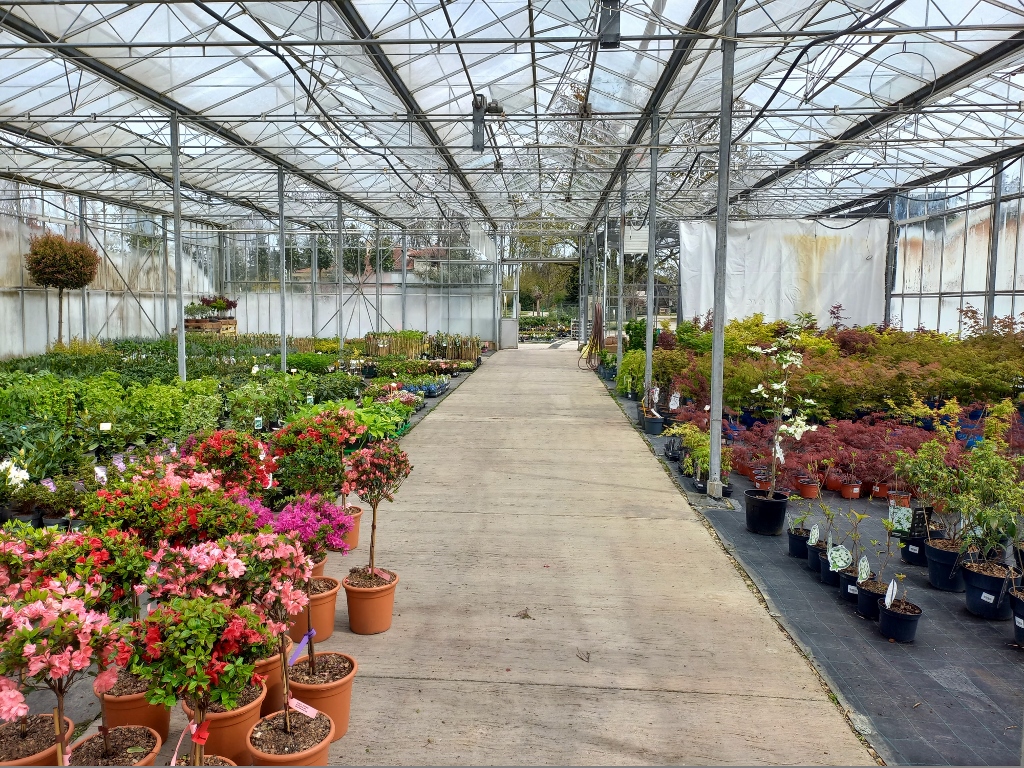 Plant nursery in Lipolist
Plant nursery in Lipolist
Not far from here, also on the way to the centre of the village, I came across an information board pointing at an ethno-village in Lipolist, so I made a stop here as well. It all seemed closed, but lovely nonetheless: at least what could be seen from the fence.
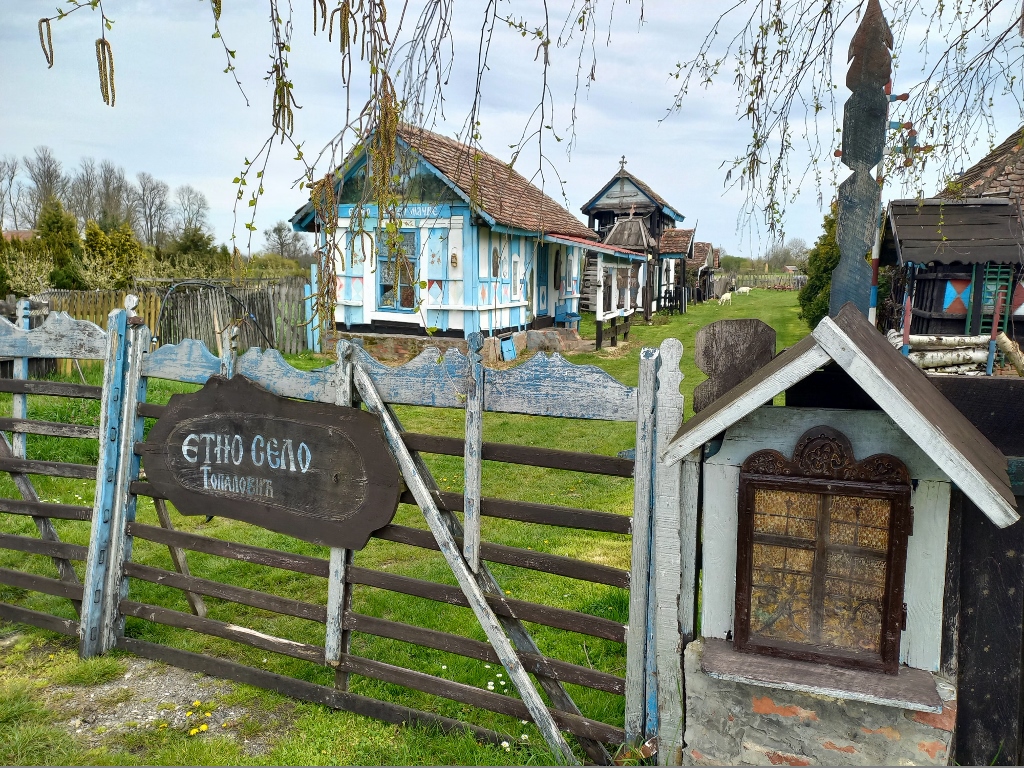 Ethno-village in Lipolist
Ethno-village in Lipolist
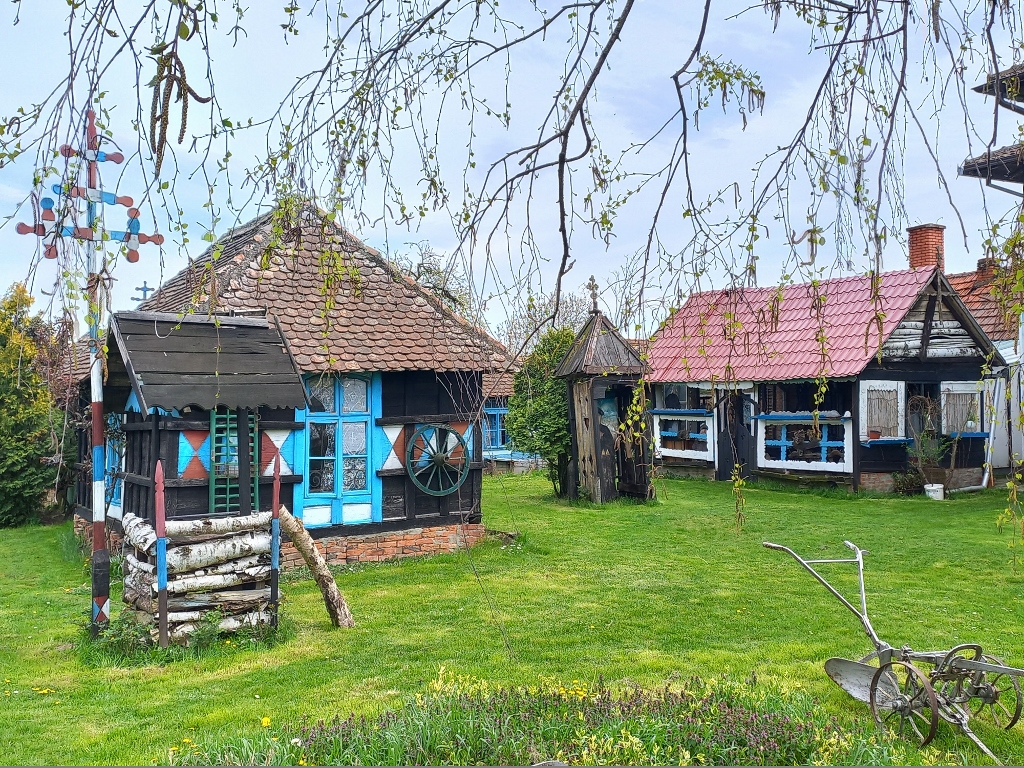 Ethno-village in Lipolist
Ethno-village in Lipolist
What I actually wanted to see in Lipolist was the Church of the Assumption of the Theotokos from 1872 that was consecrated in 1880 and that is a monument of culture today. The church is located in the very centre, so I drove there and parked.
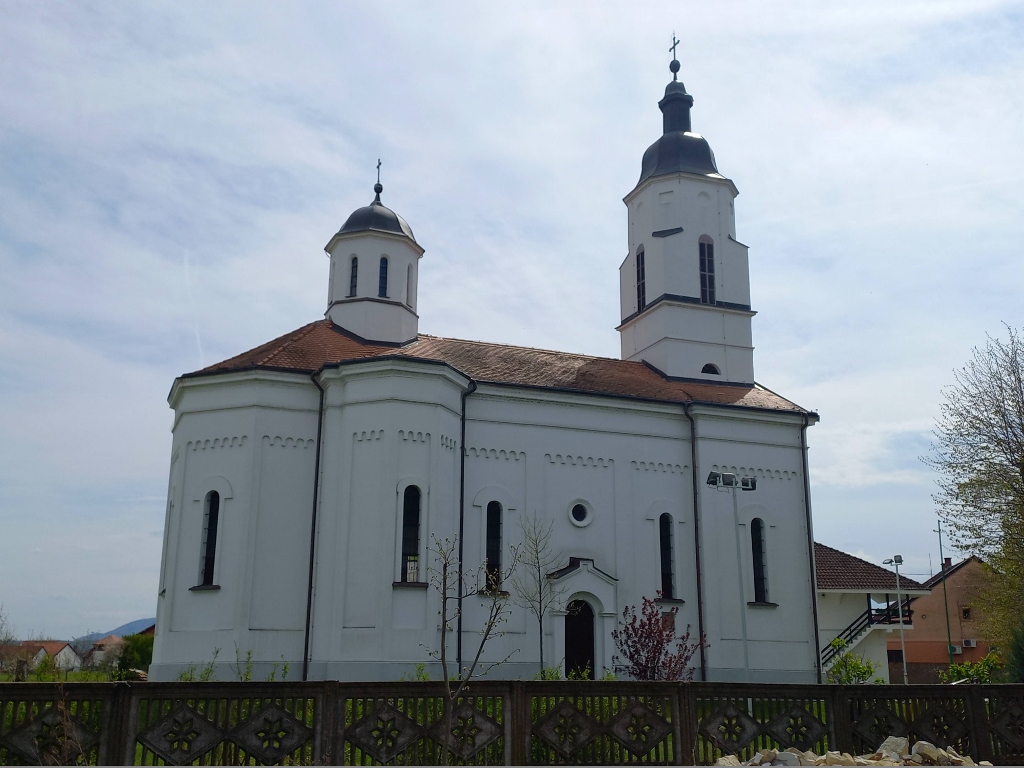 Church of the Assumption of the Theotokos
Church of the Assumption of the Theotokos
The church is rather imposing and various architectural elements clearly stand out – the apse and the choirs that are polygonal on the outside and semi-circular on the inside, the dome, as well as a tall bell tower of a relatively unusual shape. The surrounding facades have elongated window openings the shape of which is repeated on the front facade as blind niches. On the west facade, in addition to those blind niches and the bell-tower, there is also a doorway with a pediment on top. Above it, there is a circular field and this motif, albeit in a simplified form, is repeated on the north facade as well.
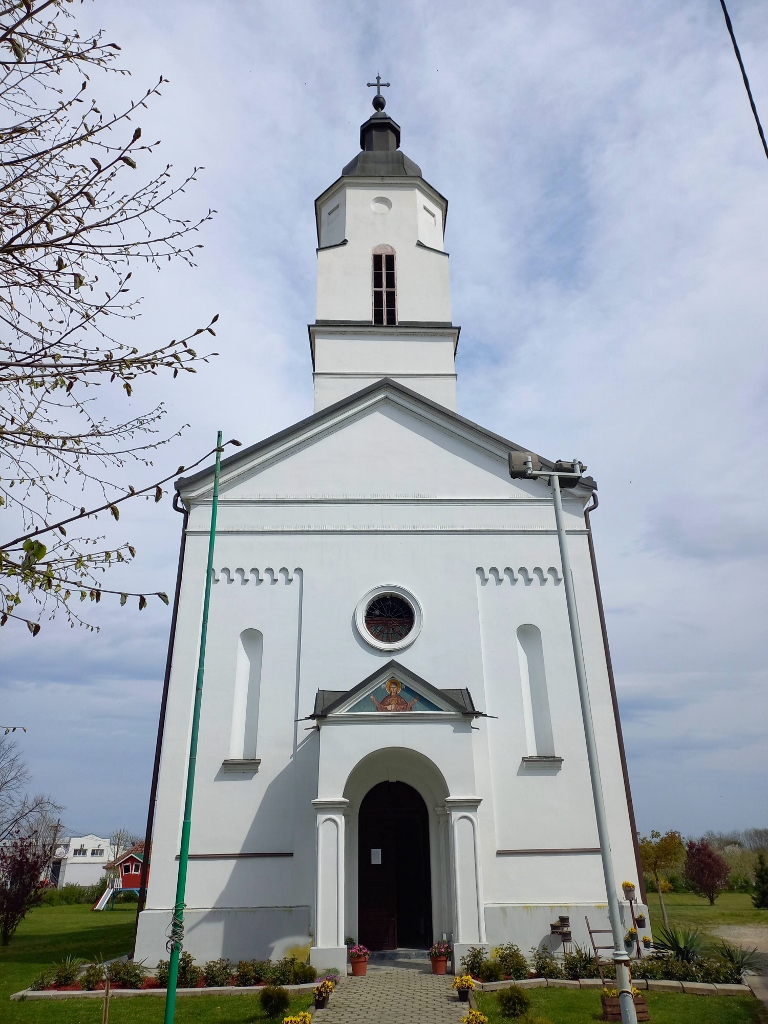 Church of the Assumption of the Theotokos
Church of the Assumption of the Theotokos
The interior is pretty and the walls are partially covered in frescoes.
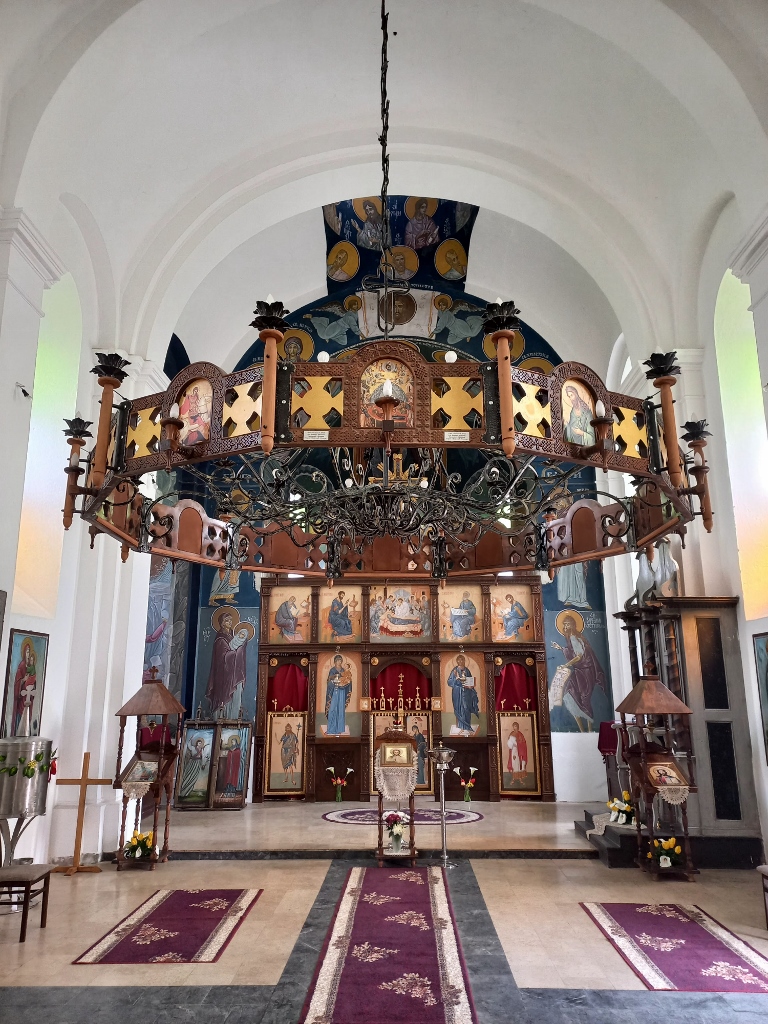 Church of the Assumption of the Theotokos
Church of the Assumption of the Theotokos
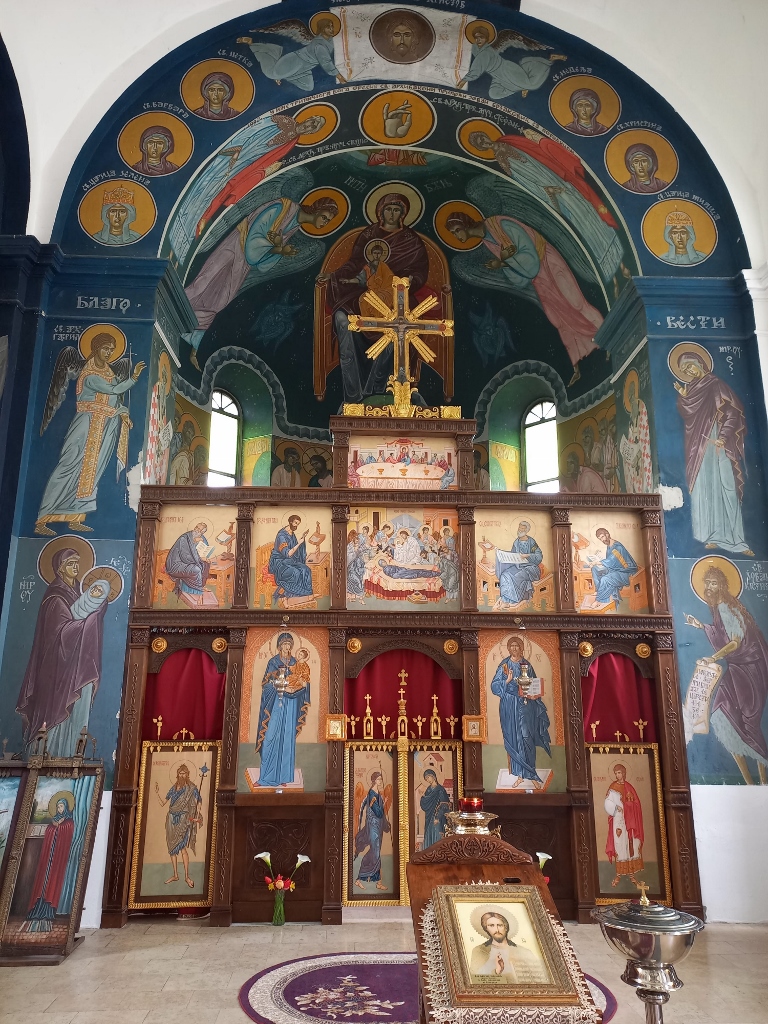 Church of the Assumption of the Theotokos
Church of the Assumption of the Theotokos
Right by the churchyard, there is a large crossroad, as well as a smallish square with two monuments. The monuments bear the names of the inhabitants of Lipolist who perished in the Balkan Wars and WWI (the white monument to the right in the photo below), as well as those killed in WWII (dark gray monument).
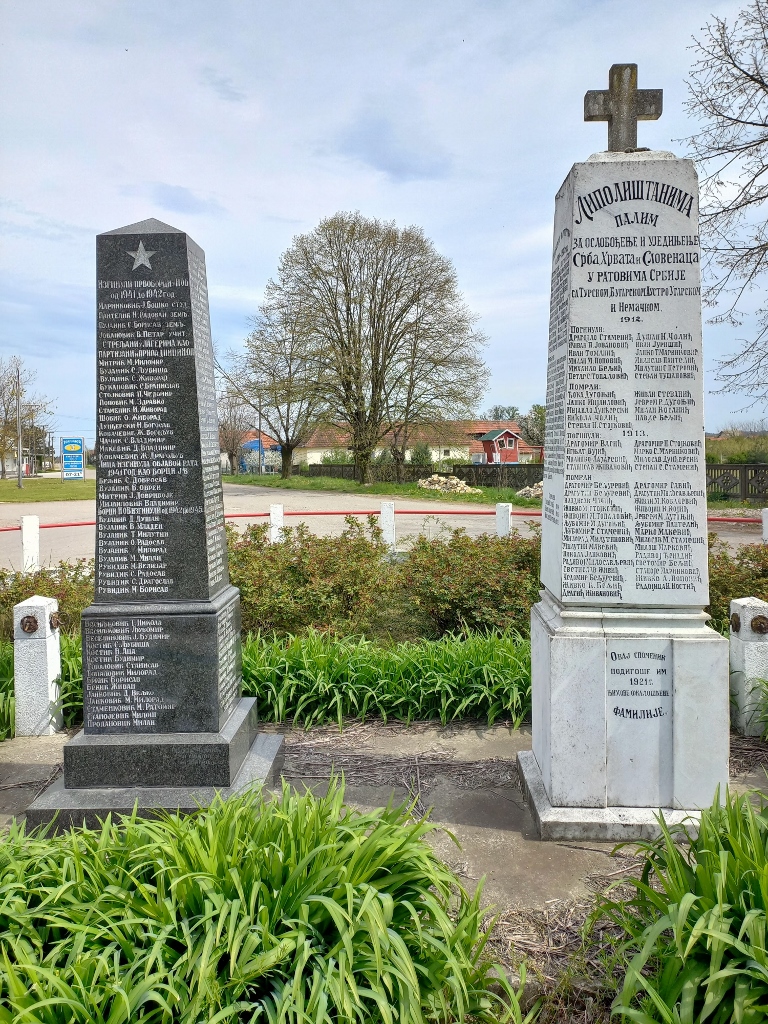 Monuments in the centre of Lipolist
Monuments in the centre of Lipolist
There are a couple of things that I found interesting here, although it is certainly quite tragic that such a high number of people from a comparatively small village (it has around 2200 inhabitants) lost their lives in these wars. First, on the white monument there is a text that reads: “To the residents of Lipolist fallen for the liberation and unification of Serbs, Croats and Slovenes in the wars of Serbia with Turkey, Bulgaria, Austria-Hungary and Germany.” The monument was erected in 1921 and by that time there was already the Kingdom of Serbs, Croats and Slovenes, later Yugoslavia, so it was quite desirable to emphasise the unity of the nations within the new country. These same nations parted ways as enemies already at the end of the 20th century.
The other interesting feature was that the monuments are standing one next to the other although they were erected in quite different socio-political periods – the one on the left-hand side was placed here when Yugoslavia was already a socialist country. I must admit that I was truly glad to see these monuments one beside the other. I think that we Serbs have suffered enough from the hands of various conquerors; this can be seen very clearly right here in this area that I visited during this journey. We have also quarrelled and fought amongst ourselves far too often. I am glad that, at least here, the honour is bestowed upon people, individuals, and not upon political allies or opponents, who are thus united in their death. It would be good if the living could follow this example.
After Lipolist I did not go back to the main road to Šabac, but rather I continued following smaller roads which I did not mind at all. I had never been to this area before and I was absolutely delighted by its beauty or I was just seduced by the loveliness of early spring.
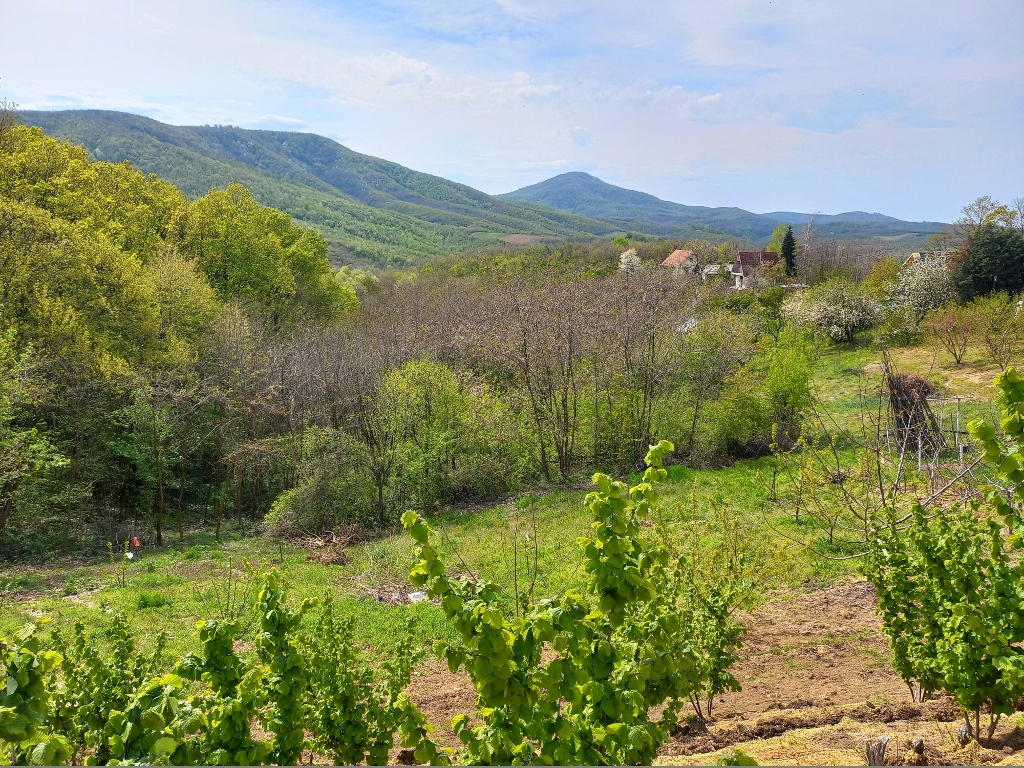 Slopes of mount Cer in early spring
Slopes of mount Cer in early spring
My next destination was Radovašnica Monastery (Радовашница). Some believe that King Dragutin Nemanjić (1252-1316) was the ktetor of the monastery, but the original monastery Church of Archangels Michael and Gabriel was mentioned for the first time in 1541. The monastery and the church were burned down several times during the Ottomans’ presence on the territory of Serbia. The church was also partially demolished in WWI, but in WWII, in October 1941, the Germans blasted it and destroyed it to the ground. At the same time, they looted everything of any worth at the monastery, while the monastery’s dormitory and other buildings were set on fire.
After the war, the restoration started very slowly. A small chapel and a residential building were made first and in 1988 the Church of Intercession of the Theotokos was built in lieu of that small chapel. The reconstruction of the old Church of the Holy Archangels Michael and Gabriel started in 2011, albeit in line with a somewhat altered design. Although the church is made of rubble stone, permission was obtained during the construction and thus some contemporary materials were used and even the roof shingles have a modern appearance. In the following photo, the new Church of the Holy Archangels Michael and Gabriel is to the left, while the Church of Intercession of the Theotokos is to the right.
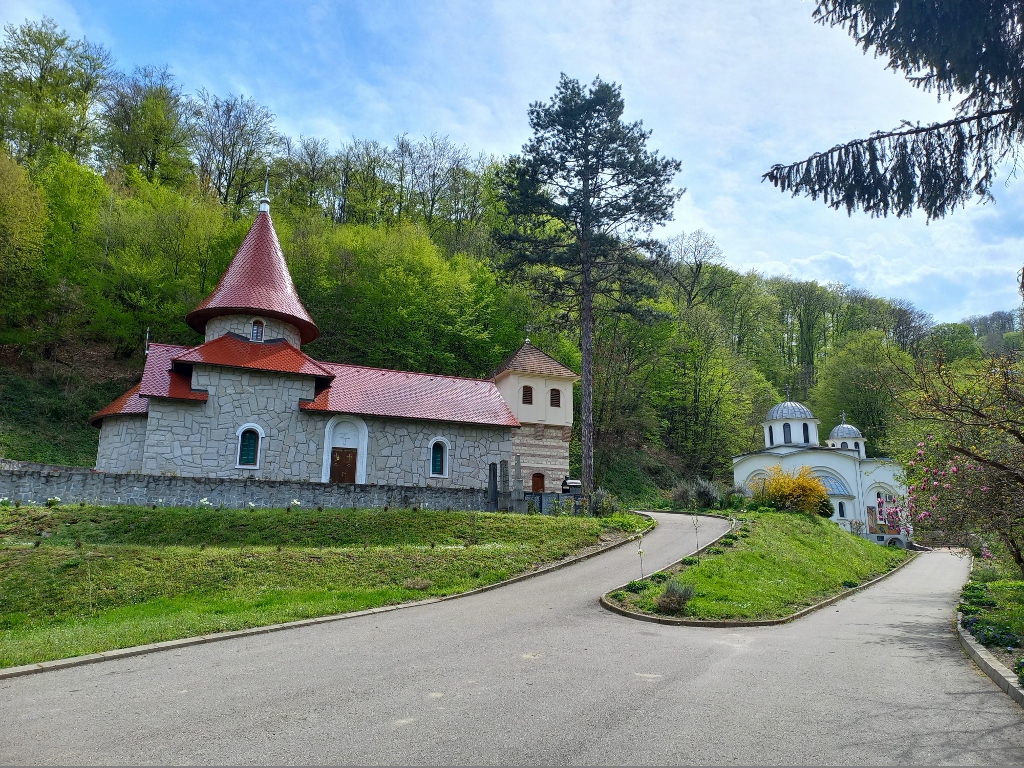 Radovašnica Monastery
Radovašnica Monastery
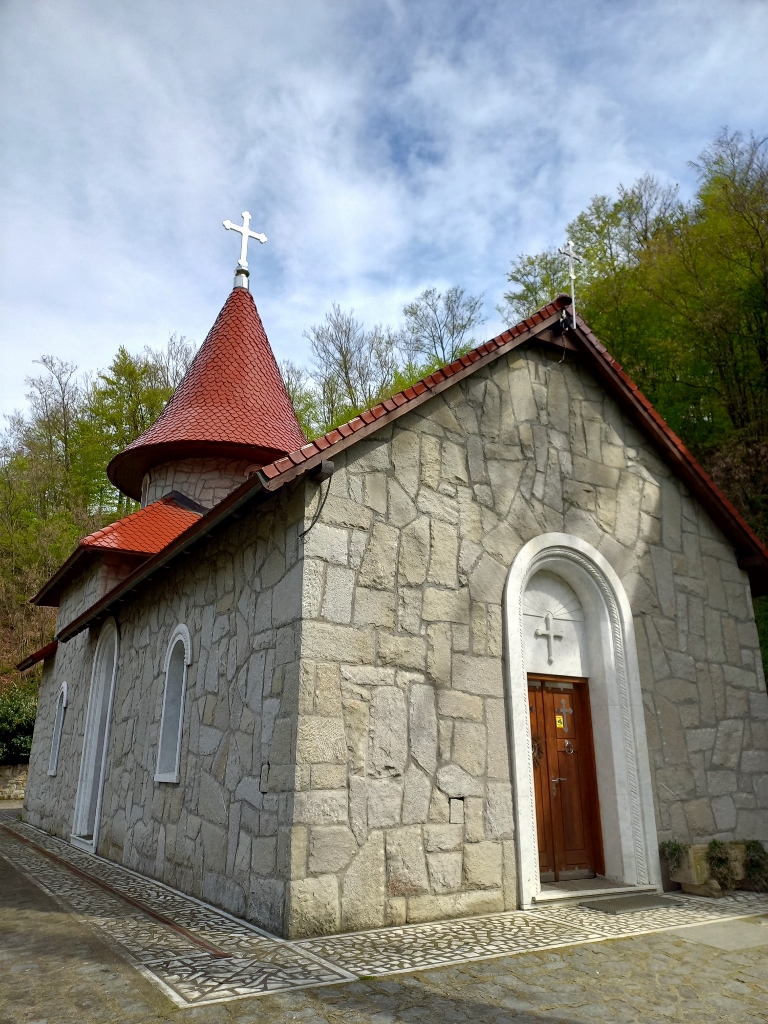 Church of the Holy Archangels Michael and Gabriel
Church of the Holy Archangels Michael and Gabriel
Since the church is new, so are the frescoes, while the iconostasis was made of marble.
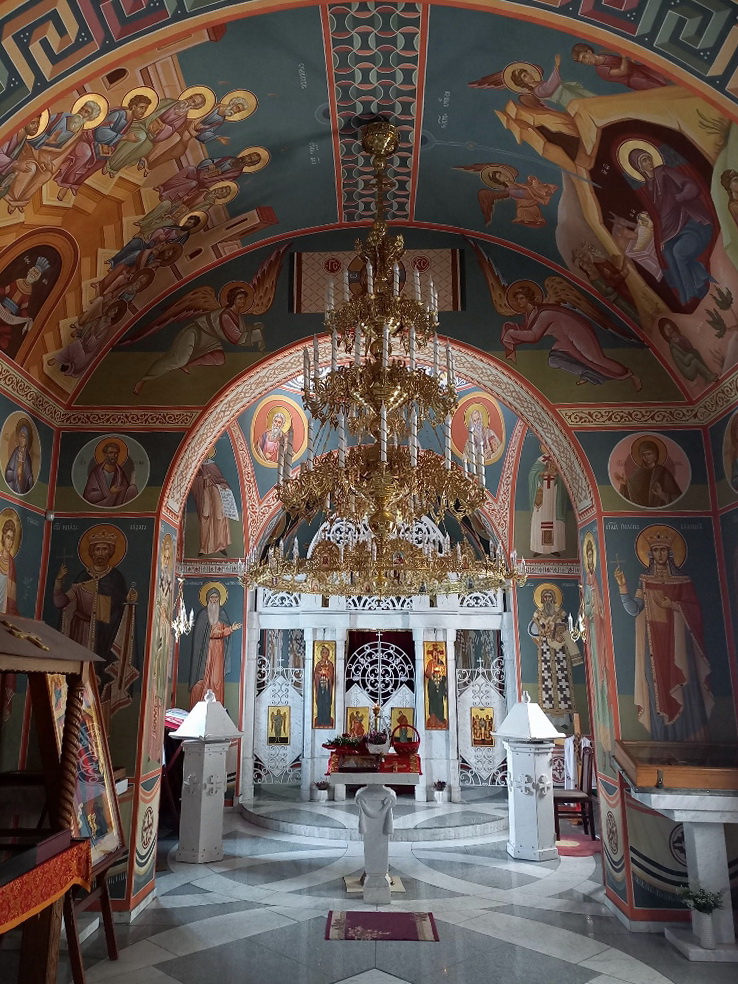 Church of the Holy Archangels Michael and Gabriel
Church of the Holy Archangels Michael and Gabriel
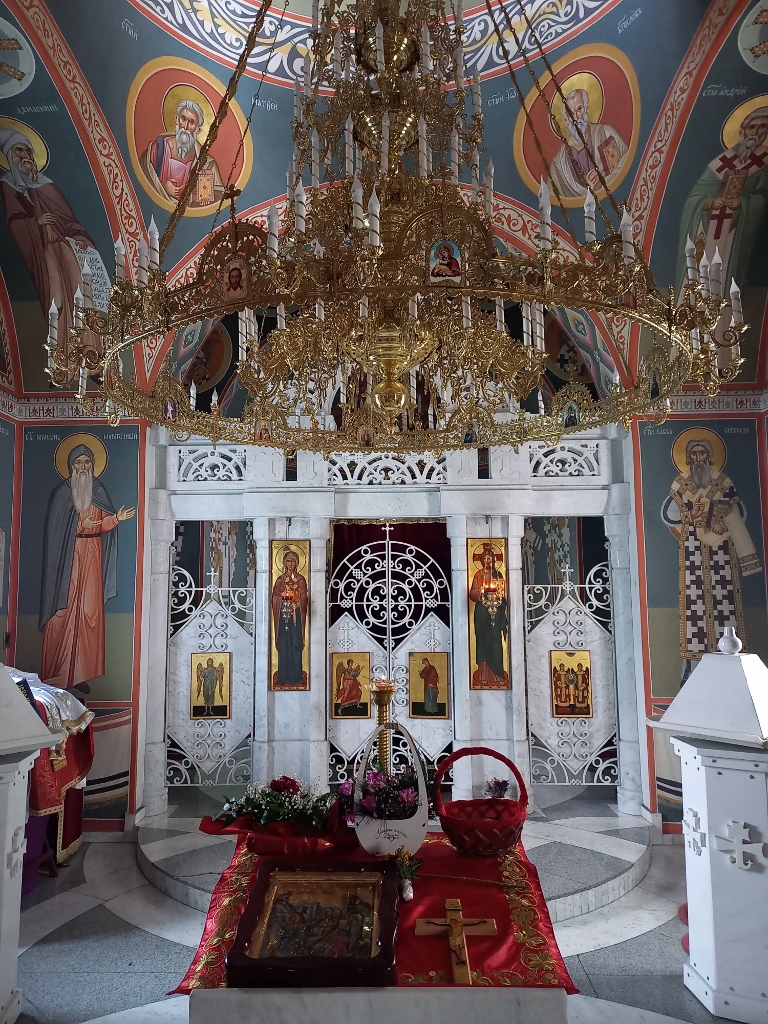 Church of the Holy Archangels Michael and Gabriel
Church of the Holy Archangels Michael and Gabriel
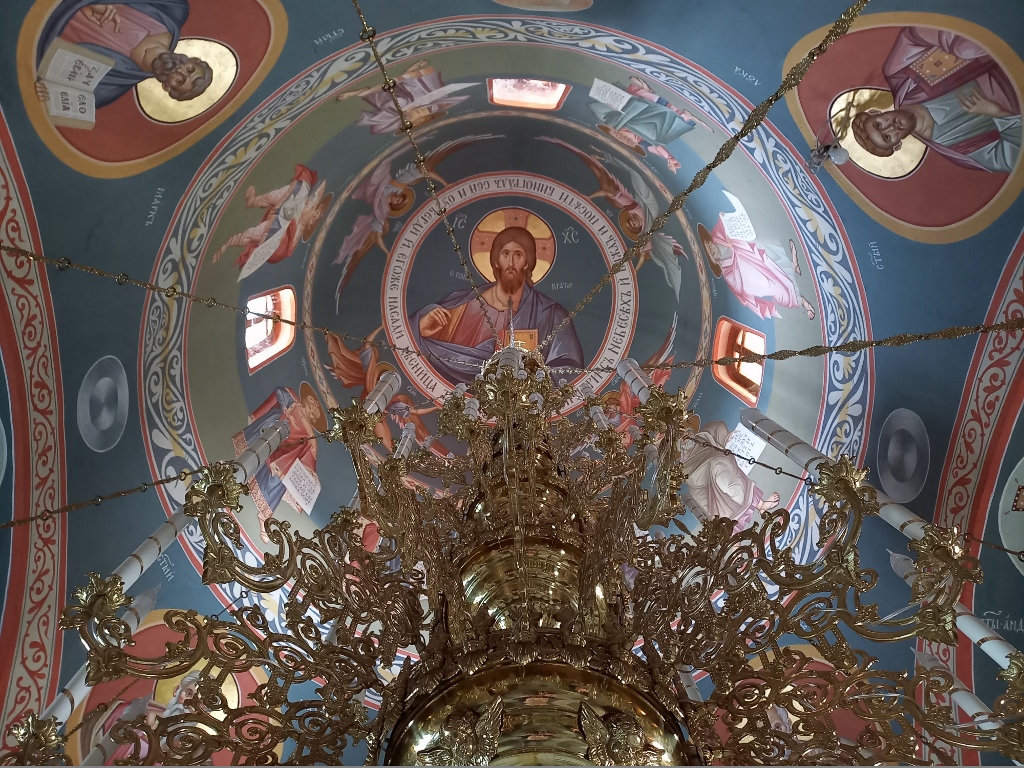 Church of the Holy Archangels Michael and Gabriel
Church of the Holy Archangels Michael and Gabriel
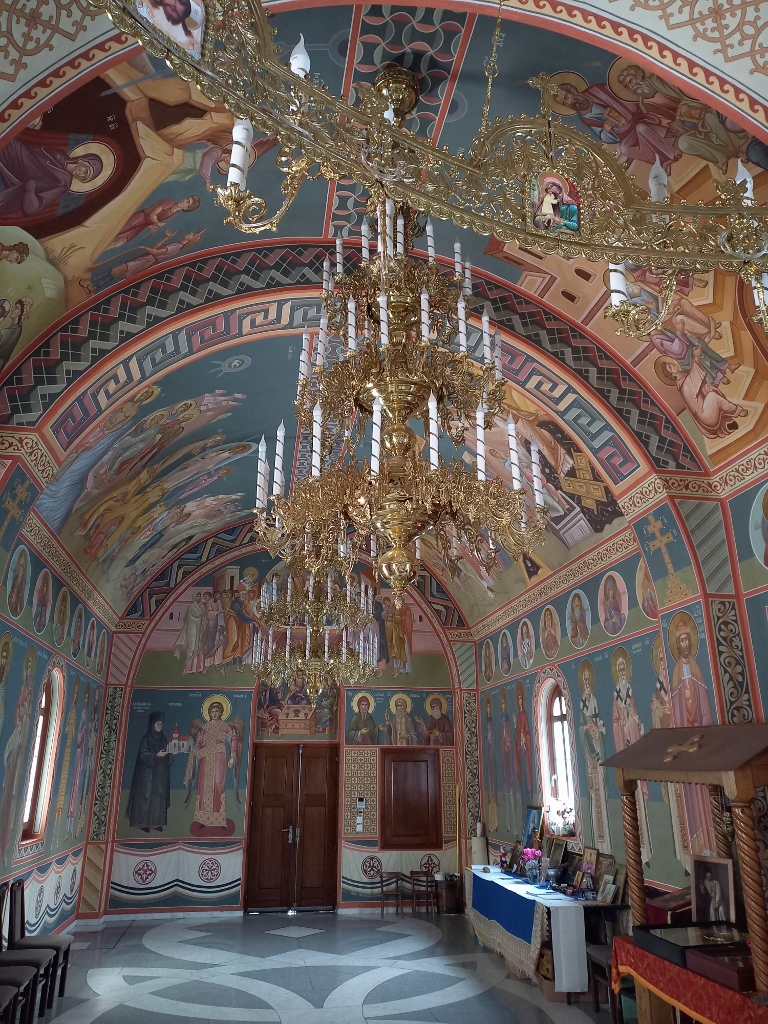 Church of the Holy Archangels Michael and Gabriel
Church of the Holy Archangels Michael and Gabriel
Then I went to have a look at the Church of Intercession of the Theotokos as well.
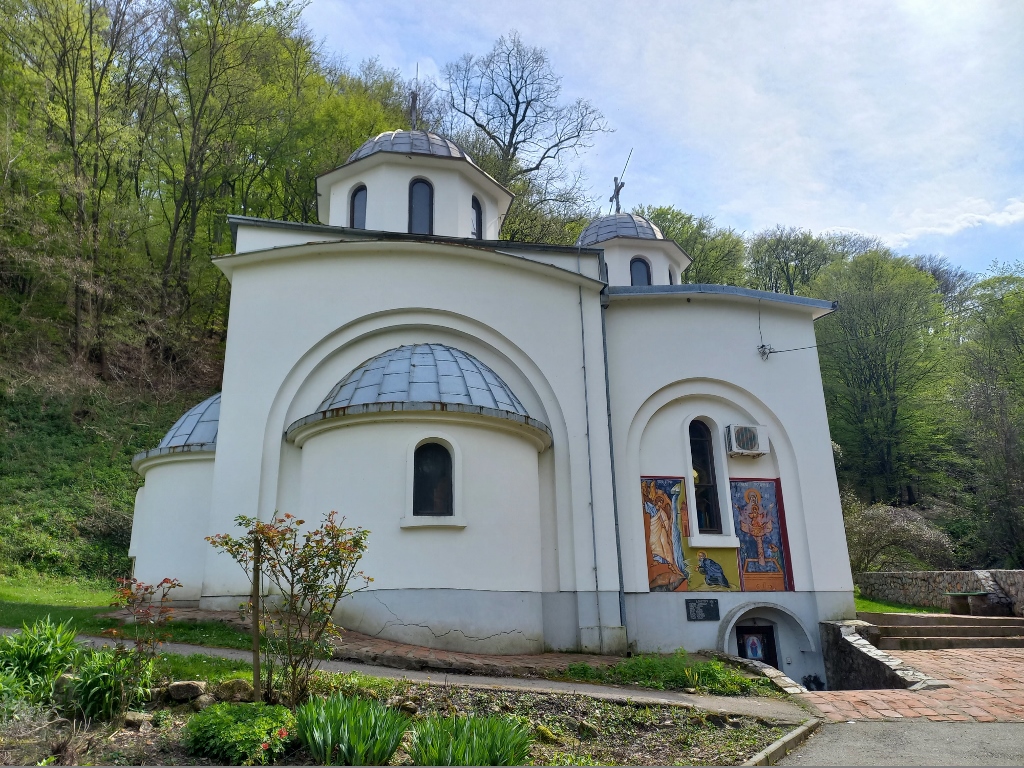 Church of Intercession of the Theotokos
Church of Intercession of the Theotokos
In the previous photo, one can notice a staircase on the right-hand side leading to the basement of the church, which is rather unusual. In fact, a spring of drinking water has been saved here under the foundations of the church since the water is believed to be very beneficial.
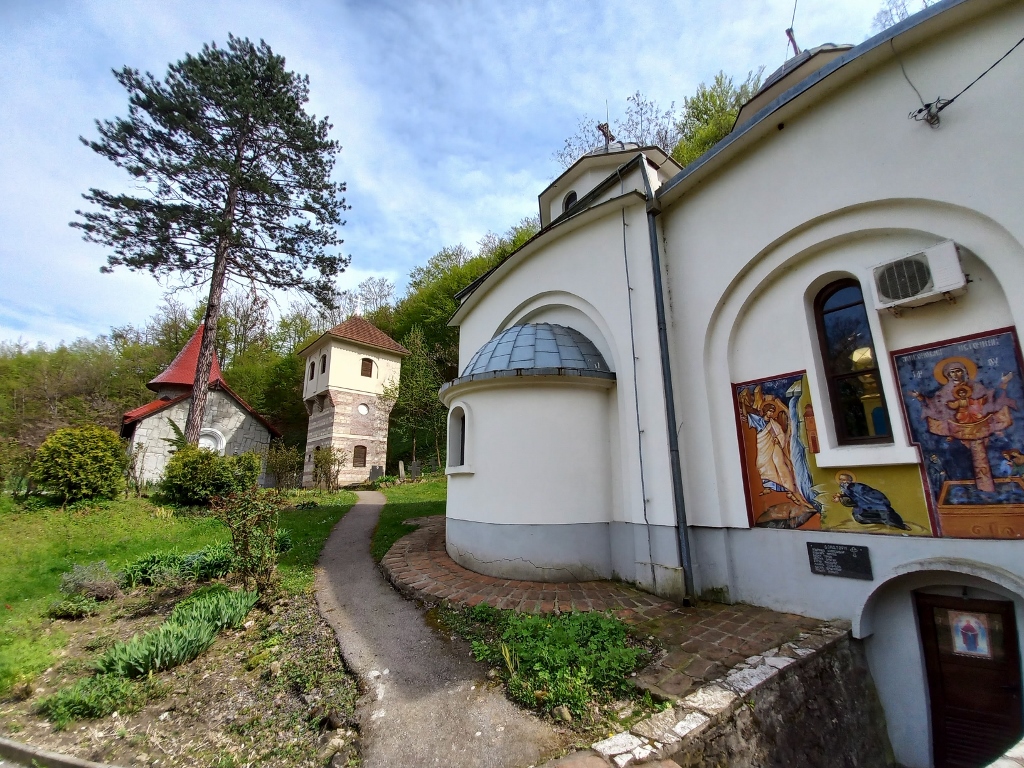 Church of Intercession of the Theotokos
Church of Intercession of the Theotokos
This church was open, too, so I visited it briefly, paying particular attention to the wonderworking icon of the Mother of God that can be seen here.
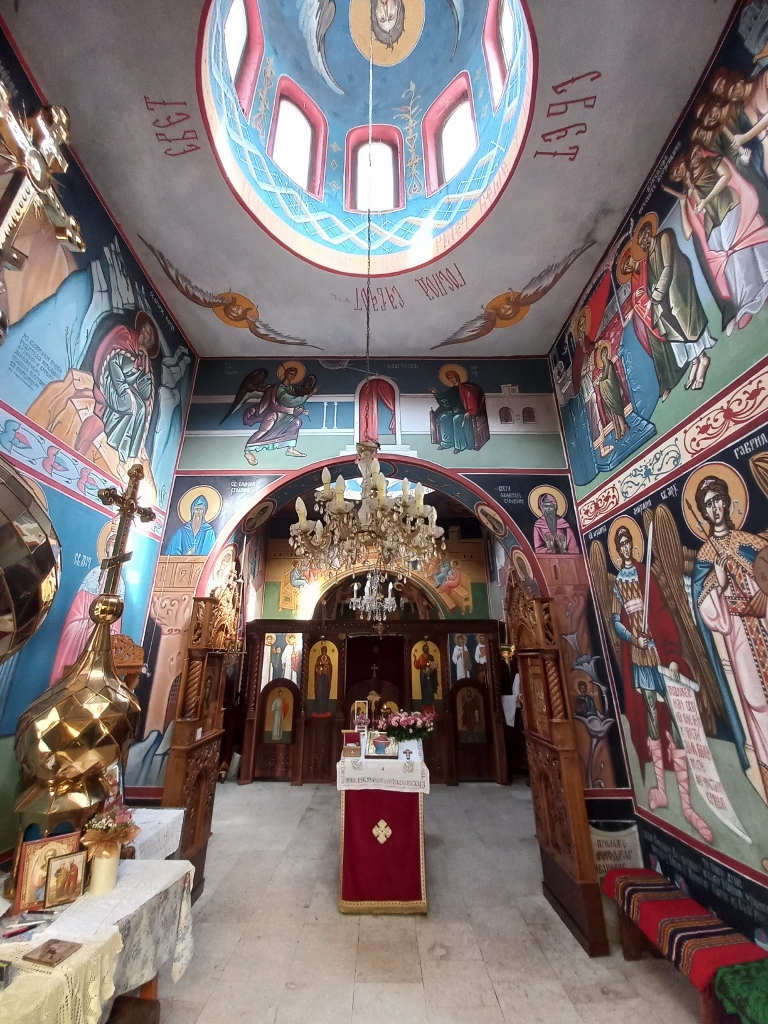 Church of Intercession of the Theotokos
Church of Intercession of the Theotokos
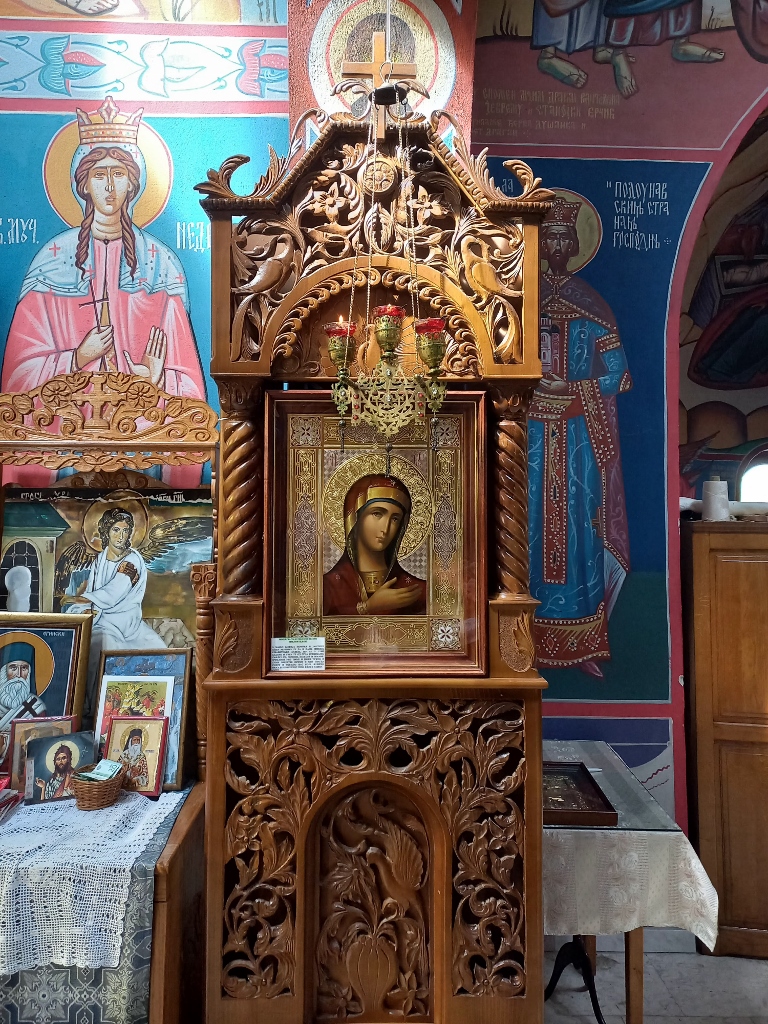 Wonderworking icon at the Church of Intercession of the Theotokos
Wonderworking icon at the Church of Intercession of the Theotokos
When I completed the visit to this church as well, I was ready to continue with my journey, for I had only one more place I wanted to visit before heading back home. Still, along the way, I had an opportunity to notice a couple of other interesting inhabitants of this area. One was a violet oil beetle (Meloe violaceus) and the other one was a common pheasant (Phasianus colchicus).
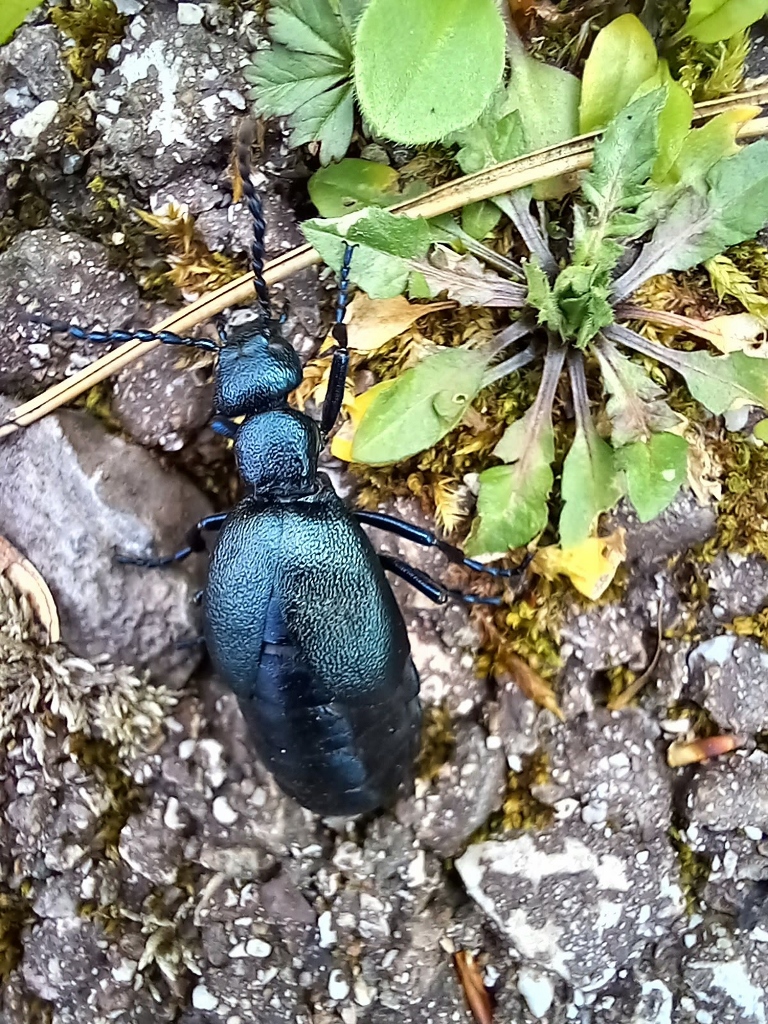 Violet oil beetle
Violet oil beetle
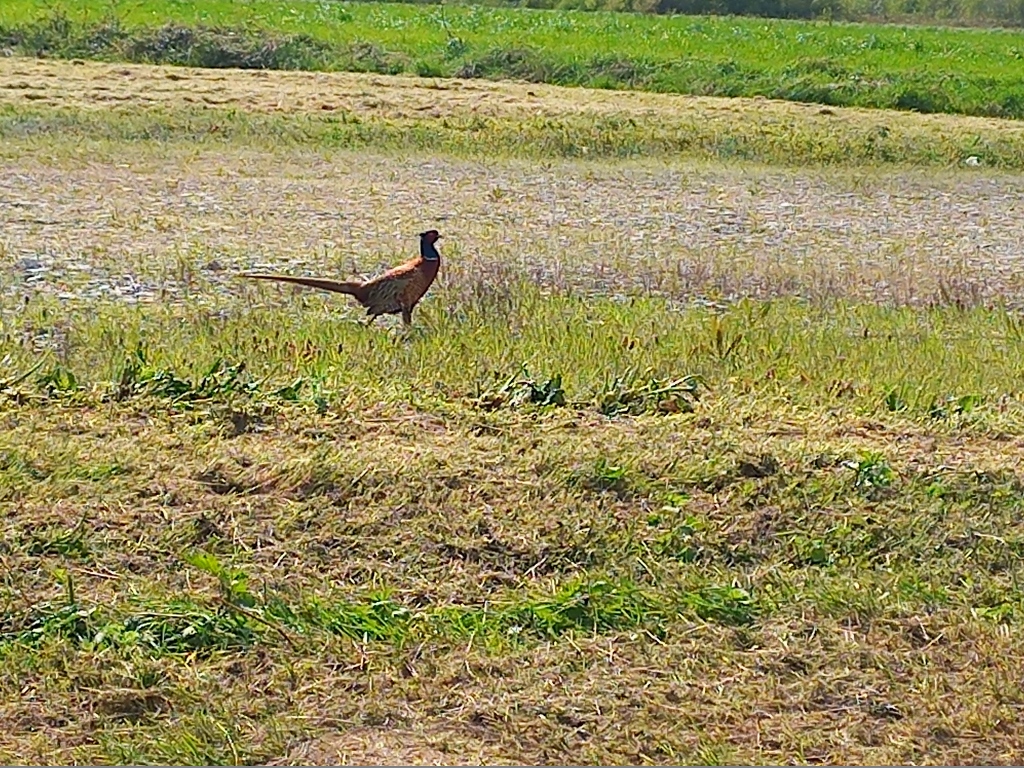 Common pheasant
Common pheasant
I drove along a local road to village Dobrić (Добрић) and I truly enjoyed the sights and landscapes around me. By now, I had left the area of mount Cer, but there were still rolling elevations. On one of them is situated the Church of Sts. Peter and Paul that belongs to village Dobrić not far from Šabac, but located actually outside the village, right close to the local graveyard.
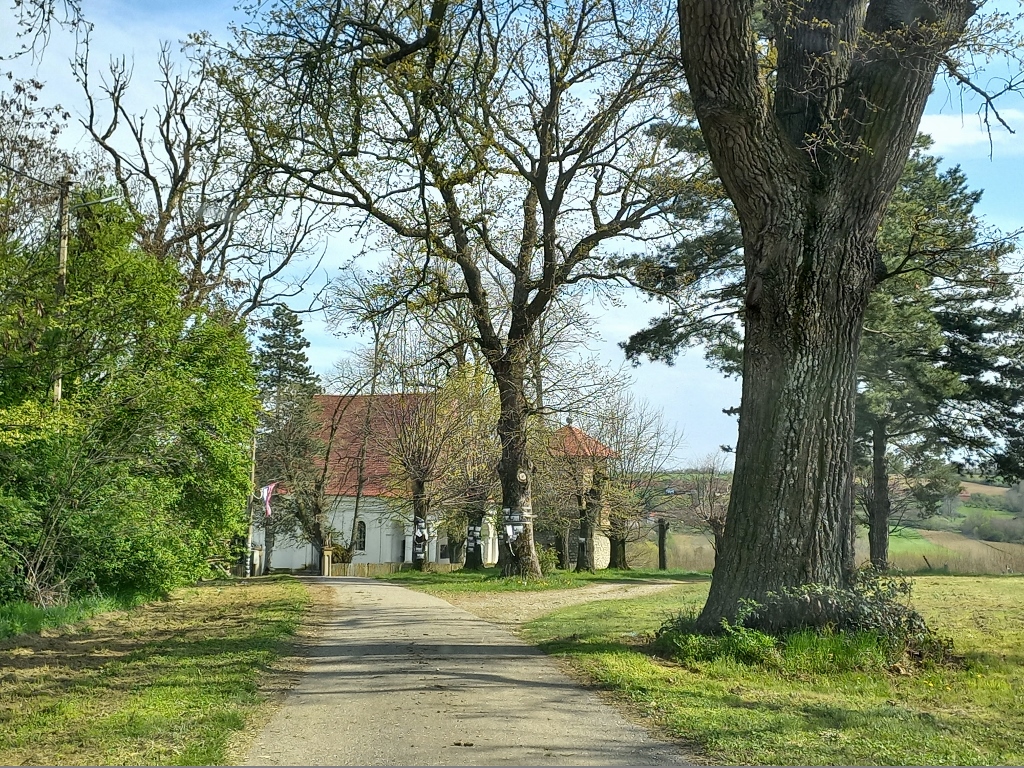 Church of Sts. Peter and Paul
Church of Sts. Peter and Paul
Back in the day, there used to be a wooden church here, but it was burned down by the Ottomans in 1815. The church that can be seen here today was built in 1827 and although it was made of solid, durable materials, with its appearance it follows the construction style used in the case of the churches made of wood and it actually looks quite lovely.
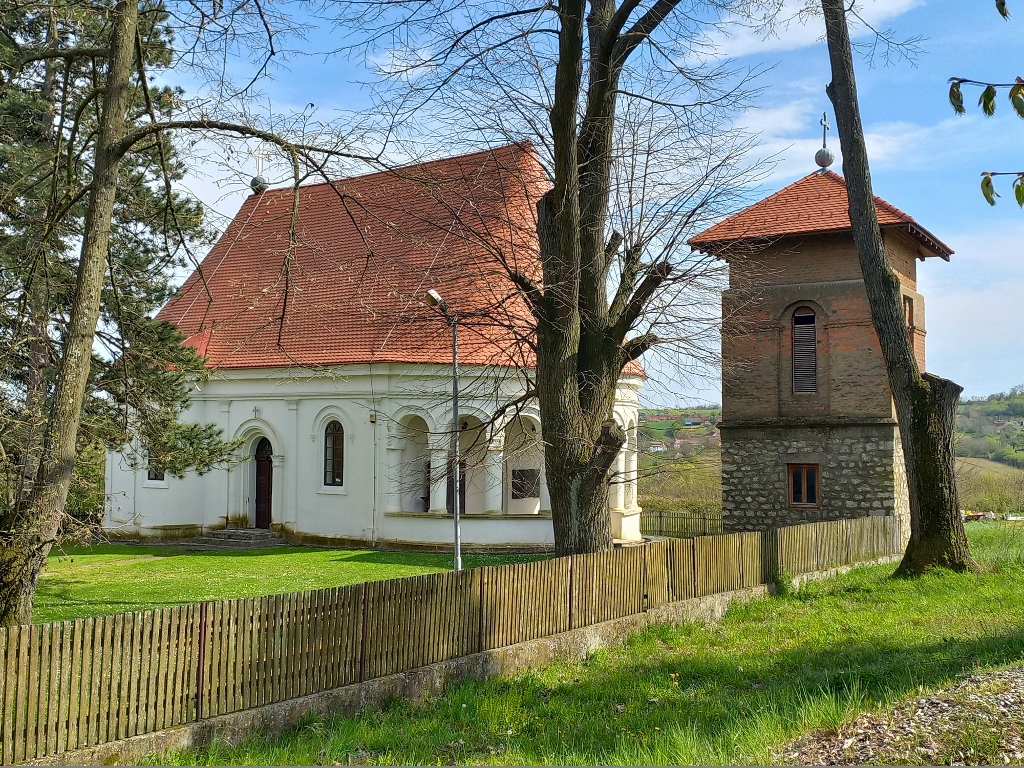 Church of Sts. Peter and Paul
Church of Sts. Peter and Paul
Thus the church has a triconch plan, while the form of the semi-circular apse is also repeated on the west side where there is a semi-open porch with a high socle and a colonnade linked by semi-circular arches. The roof was made as a single element and therefore it covers the whole structure.
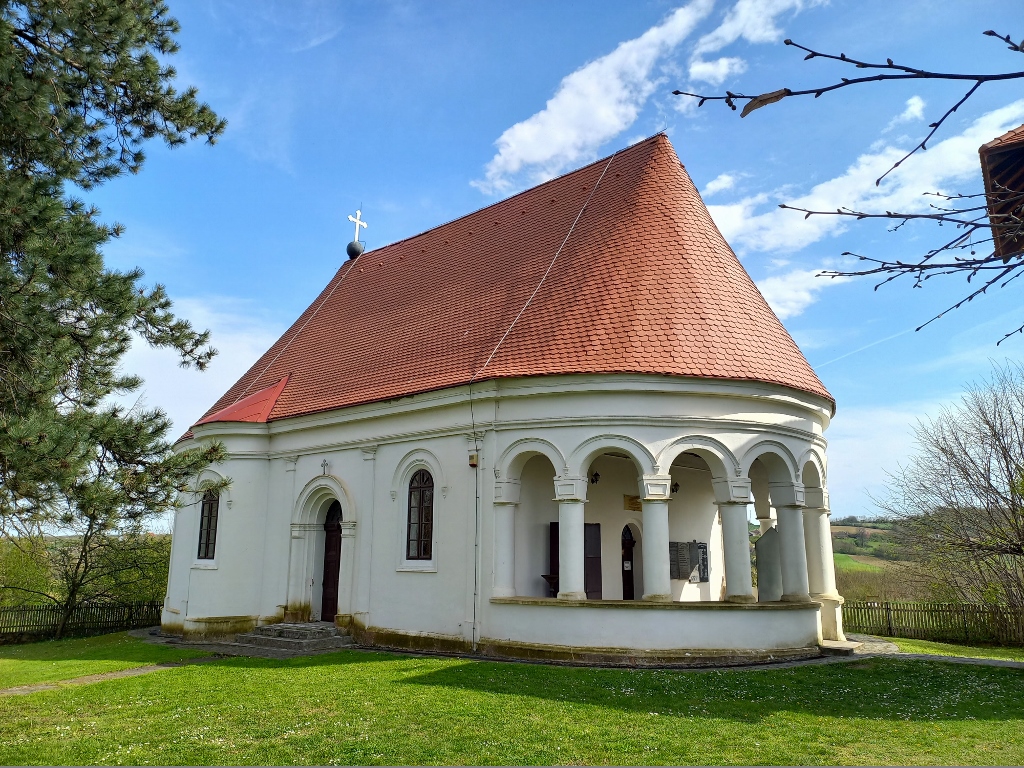 Church of Sts. Peter and Paul
Church of Sts. Peter and Paul
Unfortunately, the church was closed and there was nobody here, so I could not enter, but according to what I have read, wood is used amply in the interior, which even more reflects the clear influence of wooden churches.
As there was nobody there for me to ask any additional questions about the church, I just walked around it and around the churchyard, paying attention to some details as I strolled.
Thus, for instance, above the main entrance into the church from the porch, there is a slab saying that the church was restored in 1902 “during the reign of the King of Serbia, Alexander the First.” One should note that this is the King of Serbia, Alexander I (Obrenović) (b. 1876-1903) and not the King of Yugoslavia, Alexander I (Karađorđević) (b. 1888-1934).
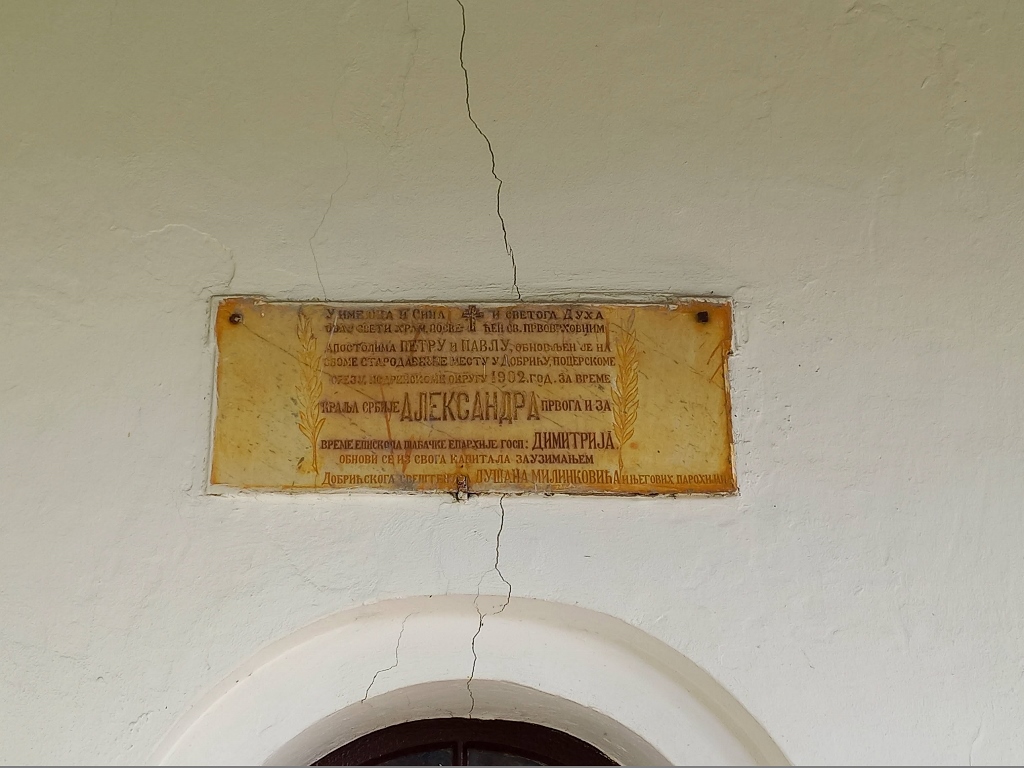 Church of Sts. Peter and Paul, a detail
Church of Sts. Peter and Paul, a detail
Beside the church there is also a gravestone from 1828, while on the other side of the churchyard there is a biggish house of a more recent date. At the time of my visit, there was nobody there either.
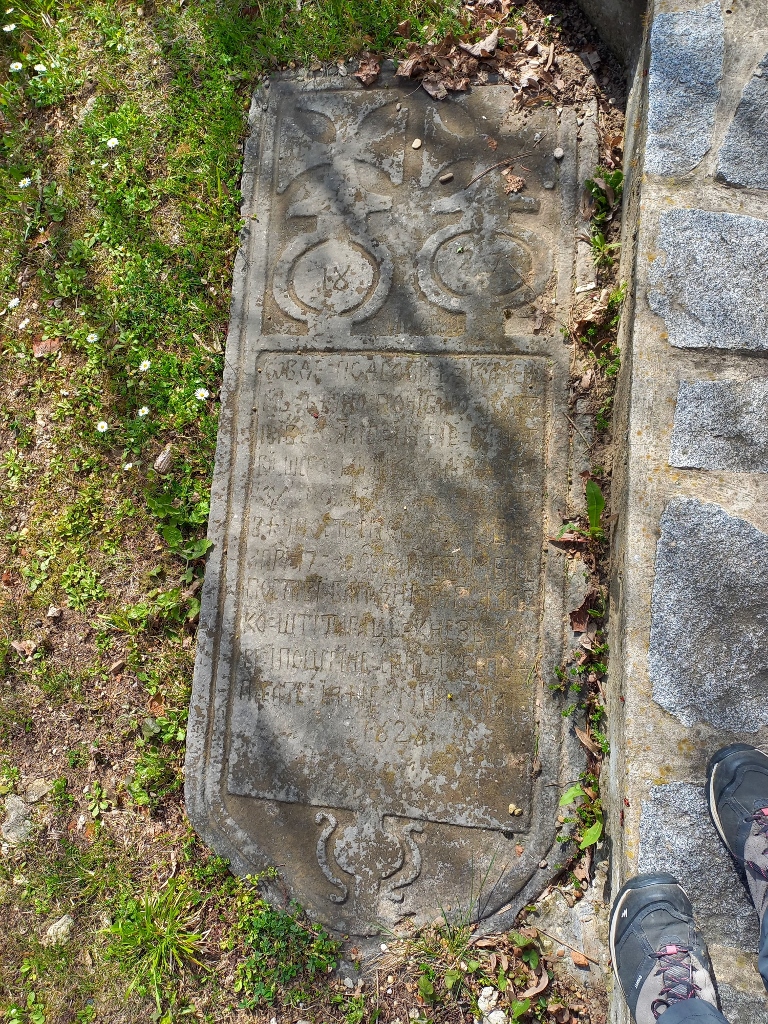 Churchyard of the Church of Sts. Peter and Paul, a detail
Churchyard of the Church of Sts. Peter and Paul, a detail
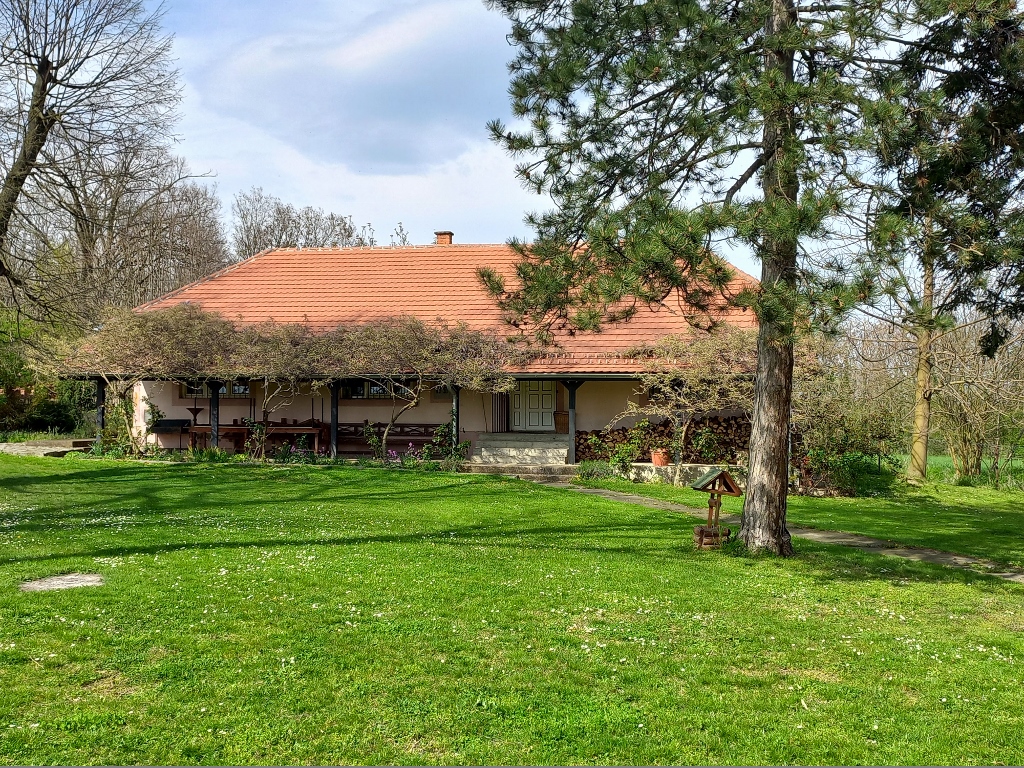 Churchyard of the Church of Sts. Peter and Paul, a detail
Churchyard of the Church of Sts. Peter and Paul, a detail
At this point, I have finished with my sightseeing of all the monuments of culture I planned to visit during this journey, so I just continued, first to Šabac, then towards Ruma, and not much later I was back at home where I could settle very content with all that I experienced and saw during this trip to Banja Koviljača and back.